Financial Resources Management: Decisions & Implications at Raddison
VerifiedAdded on 2023/04/11
|17
|4419
|112
Report
AI Summary
This report provides an in-depth analysis of managing financial resources within business organizations, with a specific focus on Raddison Plc and its expansion perspectives. It examines various internal and external sources of finance, including retained profits, sale of fixed assets, equity share...
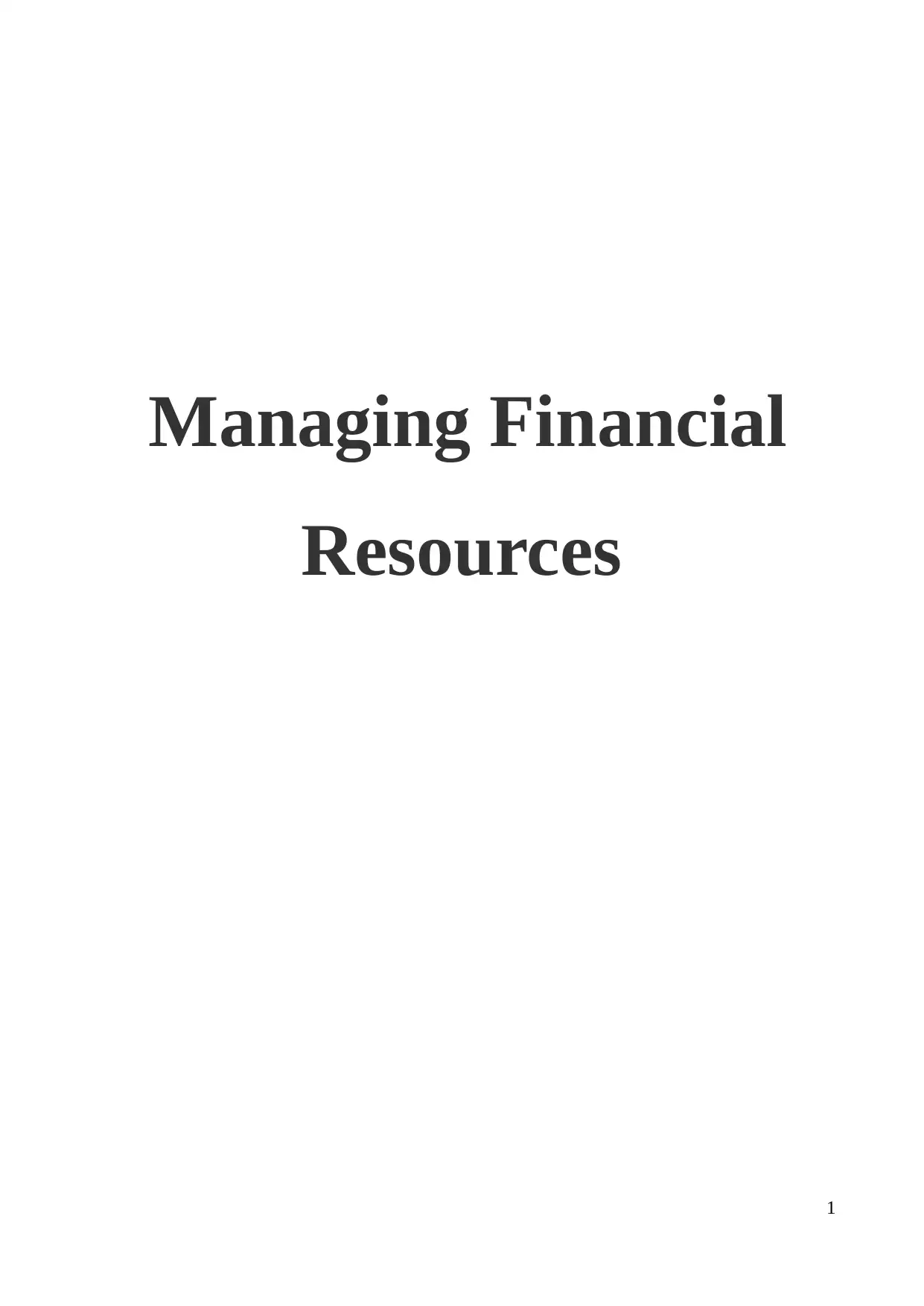
Managing Financial
Resources
1
Resources
1
Paraphrase This Document
Need a fresh take? Get an instant paraphrase of this document with our AI Paraphraser
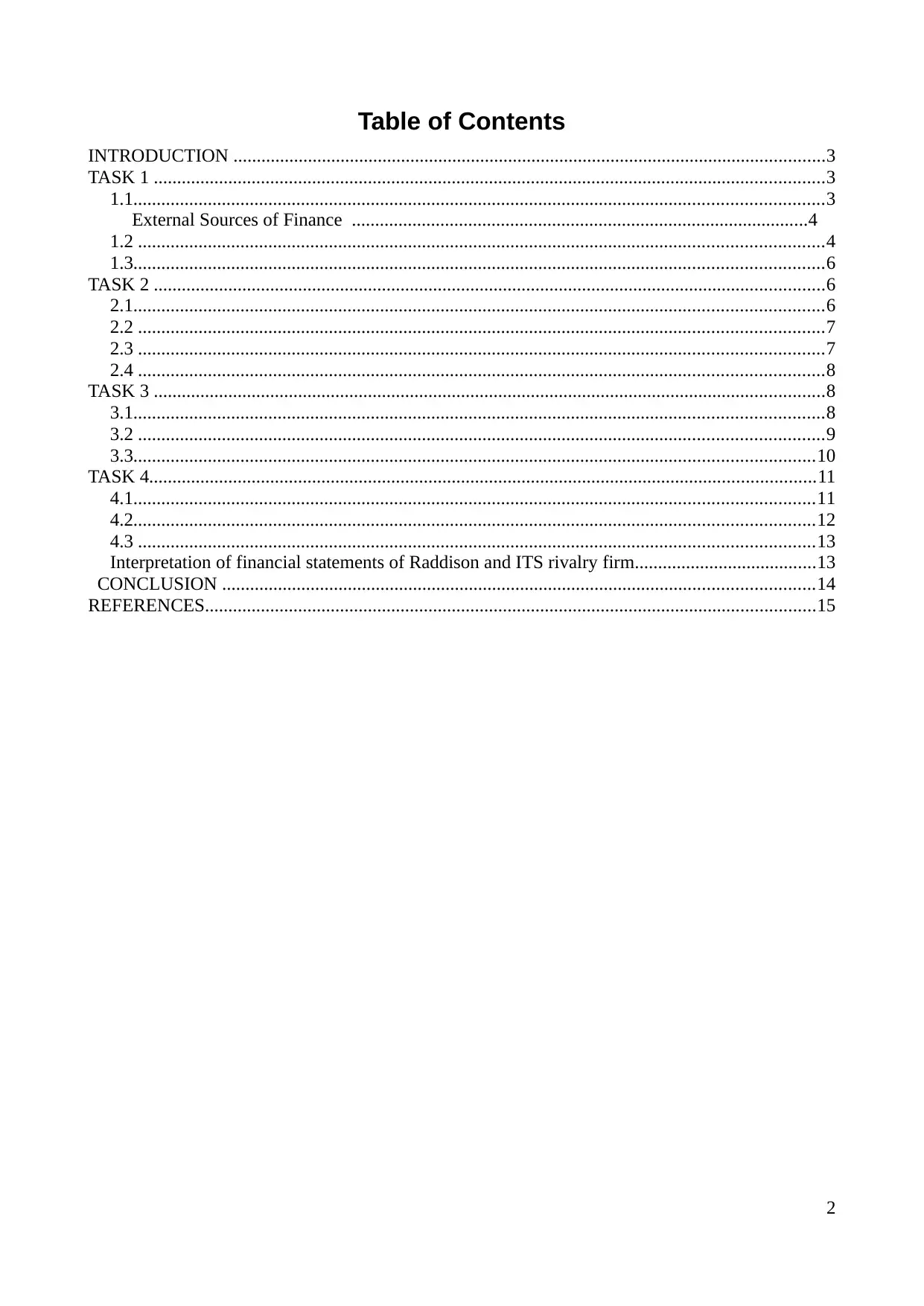
Table of Contents
INTRODUCTION ...............................................................................................................................3
TASK 1 ................................................................................................................................................3
1.1....................................................................................................................................................3
External Sources of Finance ..................................................................................................4
1.2 ...................................................................................................................................................4
1.3....................................................................................................................................................6
TASK 2 ................................................................................................................................................6
2.1....................................................................................................................................................6
2.2 ...................................................................................................................................................7
2.3 ...................................................................................................................................................7
2.4 ...................................................................................................................................................8
TASK 3 ................................................................................................................................................8
3.1....................................................................................................................................................8
3.2 ...................................................................................................................................................9
3.3..................................................................................................................................................10
TASK 4...............................................................................................................................................11
4.1..................................................................................................................................................11
4.2..................................................................................................................................................12
4.3 .................................................................................................................................................13
Interpretation of financial statements of Raddison and ITS rivalry firm.......................................13
CONCLUSION ...............................................................................................................................14
REFERENCES...................................................................................................................................15
2
INTRODUCTION ...............................................................................................................................3
TASK 1 ................................................................................................................................................3
1.1....................................................................................................................................................3
External Sources of Finance ..................................................................................................4
1.2 ...................................................................................................................................................4
1.3....................................................................................................................................................6
TASK 2 ................................................................................................................................................6
2.1....................................................................................................................................................6
2.2 ...................................................................................................................................................7
2.3 ...................................................................................................................................................7
2.4 ...................................................................................................................................................8
TASK 3 ................................................................................................................................................8
3.1....................................................................................................................................................8
3.2 ...................................................................................................................................................9
3.3..................................................................................................................................................10
TASK 4...............................................................................................................................................11
4.1..................................................................................................................................................11
4.2..................................................................................................................................................12
4.3 .................................................................................................................................................13
Interpretation of financial statements of Raddison and ITS rivalry firm.......................................13
CONCLUSION ...............................................................................................................................14
REFERENCES...................................................................................................................................15
2
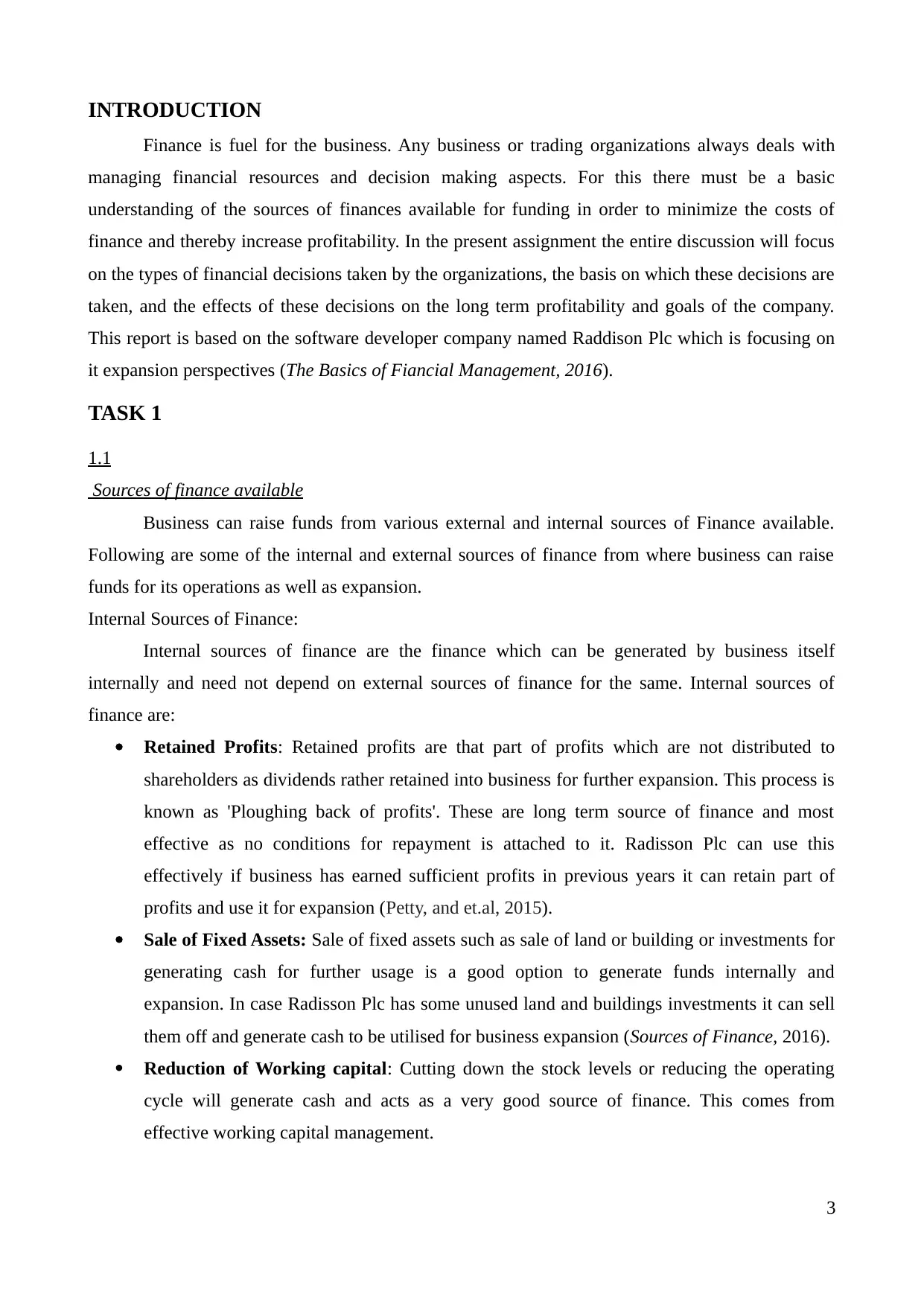
INTRODUCTION
Finance is fuel for the business. Any business or trading organizations always deals with
managing financial resources and decision making aspects. For this there must be a basic
understanding of the sources of finances available for funding in order to minimize the costs of
finance and thereby increase profitability. In the present assignment the entire discussion will focus
on the types of financial decisions taken by the organizations, the basis on which these decisions are
taken, and the effects of these decisions on the long term profitability and goals of the company.
This report is based on the software developer company named Raddison Plc which is focusing on
it expansion perspectives (The Basics of Fiancial Management, 2016).
TASK 1
1.1
Sources of finance available
Business can raise funds from various external and internal sources of Finance available.
Following are some of the internal and external sources of finance from where business can raise
funds for its operations as well as expansion.
Internal Sources of Finance:
Internal sources of finance are the finance which can be generated by business itself
internally and need not depend on external sources of finance for the same. Internal sources of
finance are:
Retained Profits: Retained profits are that part of profits which are not distributed to
shareholders as dividends rather retained into business for further expansion. This process is
known as 'Ploughing back of profits'. These are long term source of finance and most
effective as no conditions for repayment is attached to it. Radisson Plc can use this
effectively if business has earned sufficient profits in previous years it can retain part of
profits and use it for expansion (Petty, and et.al, 2015).
Sale of Fixed Assets: Sale of fixed assets such as sale of land or building or investments for
generating cash for further usage is a good option to generate funds internally and
expansion. In case Radisson Plc has some unused land and buildings investments it can sell
them off and generate cash to be utilised for business expansion (Sources of Finance, 2016).
Reduction of Working capital: Cutting down the stock levels or reducing the operating
cycle will generate cash and acts as a very good source of finance. This comes from
effective working capital management.
3
Finance is fuel for the business. Any business or trading organizations always deals with
managing financial resources and decision making aspects. For this there must be a basic
understanding of the sources of finances available for funding in order to minimize the costs of
finance and thereby increase profitability. In the present assignment the entire discussion will focus
on the types of financial decisions taken by the organizations, the basis on which these decisions are
taken, and the effects of these decisions on the long term profitability and goals of the company.
This report is based on the software developer company named Raddison Plc which is focusing on
it expansion perspectives (The Basics of Fiancial Management, 2016).
TASK 1
1.1
Sources of finance available
Business can raise funds from various external and internal sources of Finance available.
Following are some of the internal and external sources of finance from where business can raise
funds for its operations as well as expansion.
Internal Sources of Finance:
Internal sources of finance are the finance which can be generated by business itself
internally and need not depend on external sources of finance for the same. Internal sources of
finance are:
Retained Profits: Retained profits are that part of profits which are not distributed to
shareholders as dividends rather retained into business for further expansion. This process is
known as 'Ploughing back of profits'. These are long term source of finance and most
effective as no conditions for repayment is attached to it. Radisson Plc can use this
effectively if business has earned sufficient profits in previous years it can retain part of
profits and use it for expansion (Petty, and et.al, 2015).
Sale of Fixed Assets: Sale of fixed assets such as sale of land or building or investments for
generating cash for further usage is a good option to generate funds internally and
expansion. In case Radisson Plc has some unused land and buildings investments it can sell
them off and generate cash to be utilised for business expansion (Sources of Finance, 2016).
Reduction of Working capital: Cutting down the stock levels or reducing the operating
cycle will generate cash and acts as a very good source of finance. This comes from
effective working capital management.
3
⊘ This is a preview!⊘
Do you want full access?
Subscribe today to unlock all pages.

Trusted by 1+ million students worldwide
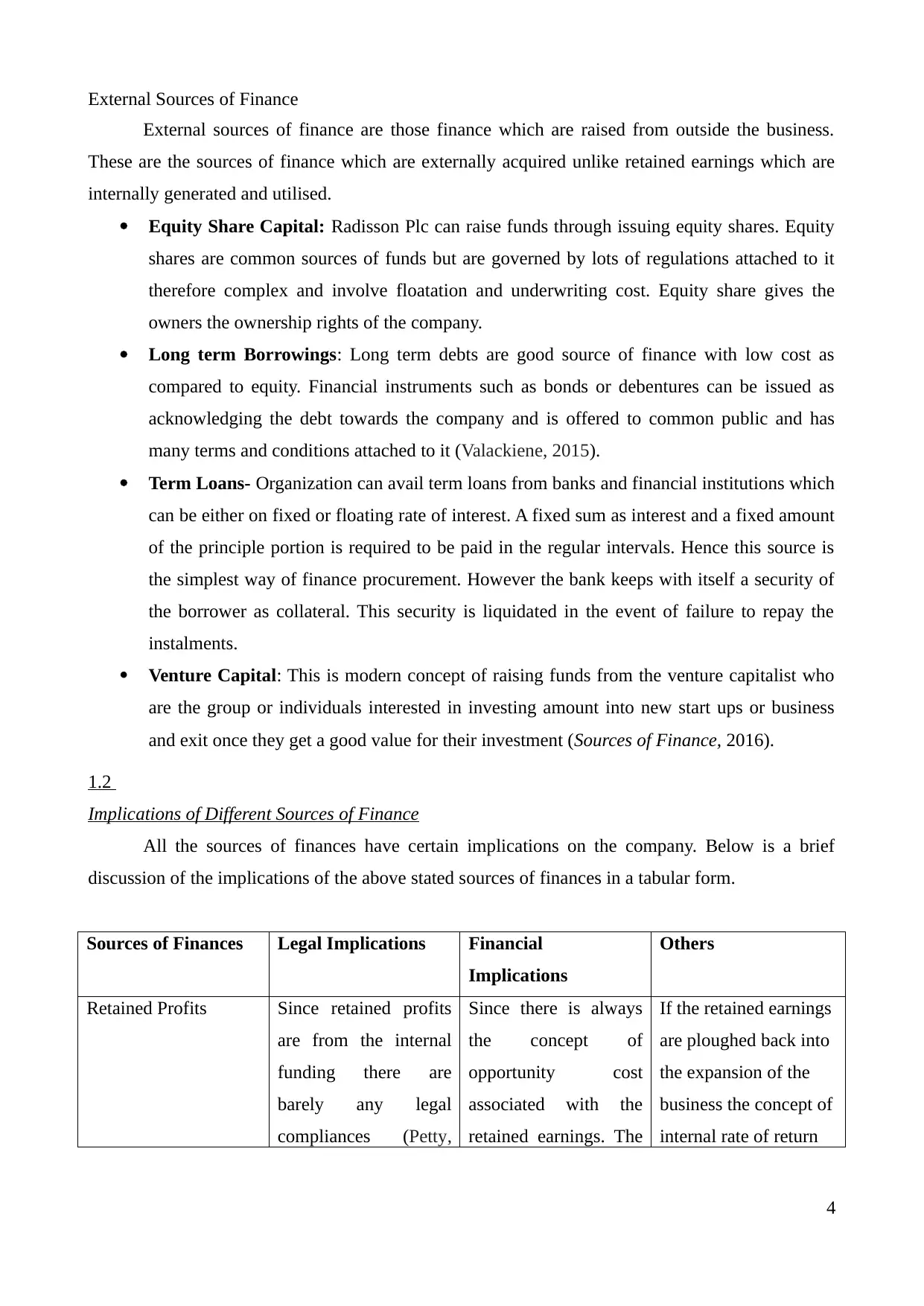
External Sources of Finance
External sources of finance are those finance which are raised from outside the business.
These are the sources of finance which are externally acquired unlike retained earnings which are
internally generated and utilised.
Equity Share Capital: Radisson Plc can raise funds through issuing equity shares. Equity
shares are common sources of funds but are governed by lots of regulations attached to it
therefore complex and involve floatation and underwriting cost. Equity share gives the
owners the ownership rights of the company.
Long term Borrowings: Long term debts are good source of finance with low cost as
compared to equity. Financial instruments such as bonds or debentures can be issued as
acknowledging the debt towards the company and is offered to common public and has
many terms and conditions attached to it (Valackiene, 2015).
Term Loans- Organization can avail term loans from banks and financial institutions which
can be either on fixed or floating rate of interest. A fixed sum as interest and a fixed amount
of the principle portion is required to be paid in the regular intervals. Hence this source is
the simplest way of finance procurement. However the bank keeps with itself a security of
the borrower as collateral. This security is liquidated in the event of failure to repay the
instalments.
Venture Capital: This is modern concept of raising funds from the venture capitalist who
are the group or individuals interested in investing amount into new start ups or business
and exit once they get a good value for their investment (Sources of Finance, 2016).
1.2
Implications of Different Sources of Finance
All the sources of finances have certain implications on the company. Below is a brief
discussion of the implications of the above stated sources of finances in a tabular form.
Sources of Finances Legal Implications Financial
Implications
Others
Retained Profits Since retained profits
are from the internal
funding there are
barely any legal
compliances (Petty,
Since there is always
the concept of
opportunity cost
associated with the
retained earnings. The
If the retained earnings
are ploughed back into
the expansion of the
business the concept of
internal rate of return
4
External sources of finance are those finance which are raised from outside the business.
These are the sources of finance which are externally acquired unlike retained earnings which are
internally generated and utilised.
Equity Share Capital: Radisson Plc can raise funds through issuing equity shares. Equity
shares are common sources of funds but are governed by lots of regulations attached to it
therefore complex and involve floatation and underwriting cost. Equity share gives the
owners the ownership rights of the company.
Long term Borrowings: Long term debts are good source of finance with low cost as
compared to equity. Financial instruments such as bonds or debentures can be issued as
acknowledging the debt towards the company and is offered to common public and has
many terms and conditions attached to it (Valackiene, 2015).
Term Loans- Organization can avail term loans from banks and financial institutions which
can be either on fixed or floating rate of interest. A fixed sum as interest and a fixed amount
of the principle portion is required to be paid in the regular intervals. Hence this source is
the simplest way of finance procurement. However the bank keeps with itself a security of
the borrower as collateral. This security is liquidated in the event of failure to repay the
instalments.
Venture Capital: This is modern concept of raising funds from the venture capitalist who
are the group or individuals interested in investing amount into new start ups or business
and exit once they get a good value for their investment (Sources of Finance, 2016).
1.2
Implications of Different Sources of Finance
All the sources of finances have certain implications on the company. Below is a brief
discussion of the implications of the above stated sources of finances in a tabular form.
Sources of Finances Legal Implications Financial
Implications
Others
Retained Profits Since retained profits
are from the internal
funding there are
barely any legal
compliances (Petty,
Since there is always
the concept of
opportunity cost
associated with the
retained earnings. The
If the retained earnings
are ploughed back into
the expansion of the
business the concept of
internal rate of return
4
Paraphrase This Document
Need a fresh take? Get an instant paraphrase of this document with our AI Paraphraser
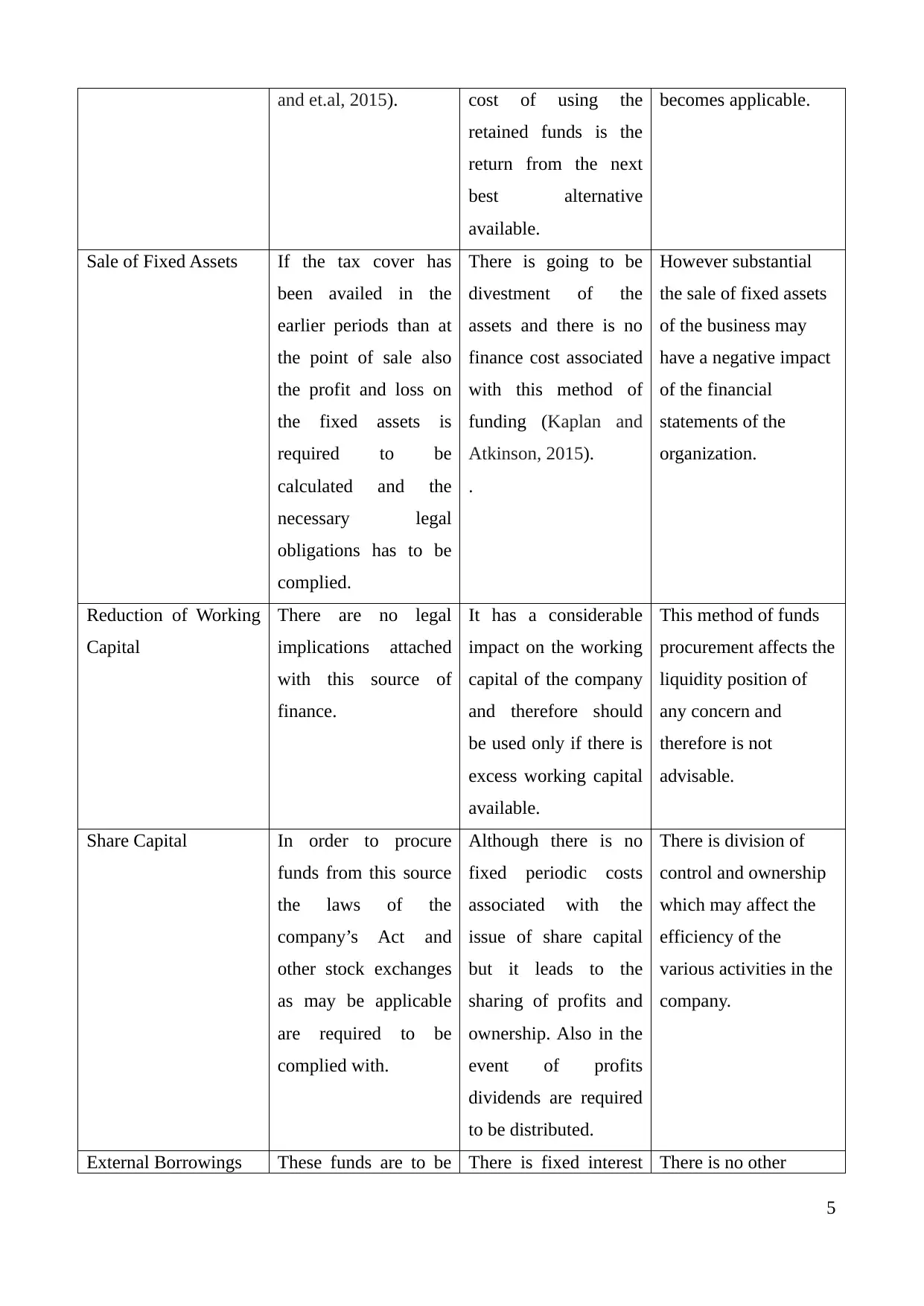
and et.al, 2015). cost of using the
retained funds is the
return from the next
best alternative
available.
becomes applicable.
Sale of Fixed Assets If the tax cover has
been availed in the
earlier periods than at
the point of sale also
the profit and loss on
the fixed assets is
required to be
calculated and the
necessary legal
obligations has to be
complied.
There is going to be
divestment of the
assets and there is no
finance cost associated
with this method of
funding (Kaplan and
Atkinson, 2015).
.
However substantial
the sale of fixed assets
of the business may
have a negative impact
of the financial
statements of the
organization.
Reduction of Working
Capital
There are no legal
implications attached
with this source of
finance.
It has a considerable
impact on the working
capital of the company
and therefore should
be used only if there is
excess working capital
available.
This method of funds
procurement affects the
liquidity position of
any concern and
therefore is not
advisable.
Share Capital In order to procure
funds from this source
the laws of the
company’s Act and
other stock exchanges
as may be applicable
are required to be
complied with.
Although there is no
fixed periodic costs
associated with the
issue of share capital
but it leads to the
sharing of profits and
ownership. Also in the
event of profits
dividends are required
to be distributed.
There is division of
control and ownership
which may affect the
efficiency of the
various activities in the
company.
External Borrowings These funds are to be There is fixed interest There is no other
5
retained funds is the
return from the next
best alternative
available.
becomes applicable.
Sale of Fixed Assets If the tax cover has
been availed in the
earlier periods than at
the point of sale also
the profit and loss on
the fixed assets is
required to be
calculated and the
necessary legal
obligations has to be
complied.
There is going to be
divestment of the
assets and there is no
finance cost associated
with this method of
funding (Kaplan and
Atkinson, 2015).
.
However substantial
the sale of fixed assets
of the business may
have a negative impact
of the financial
statements of the
organization.
Reduction of Working
Capital
There are no legal
implications attached
with this source of
finance.
It has a considerable
impact on the working
capital of the company
and therefore should
be used only if there is
excess working capital
available.
This method of funds
procurement affects the
liquidity position of
any concern and
therefore is not
advisable.
Share Capital In order to procure
funds from this source
the laws of the
company’s Act and
other stock exchanges
as may be applicable
are required to be
complied with.
Although there is no
fixed periodic costs
associated with the
issue of share capital
but it leads to the
sharing of profits and
ownership. Also in the
event of profits
dividends are required
to be distributed.
There is division of
control and ownership
which may affect the
efficiency of the
various activities in the
company.
External Borrowings These funds are to be There is fixed interest There is no other
5
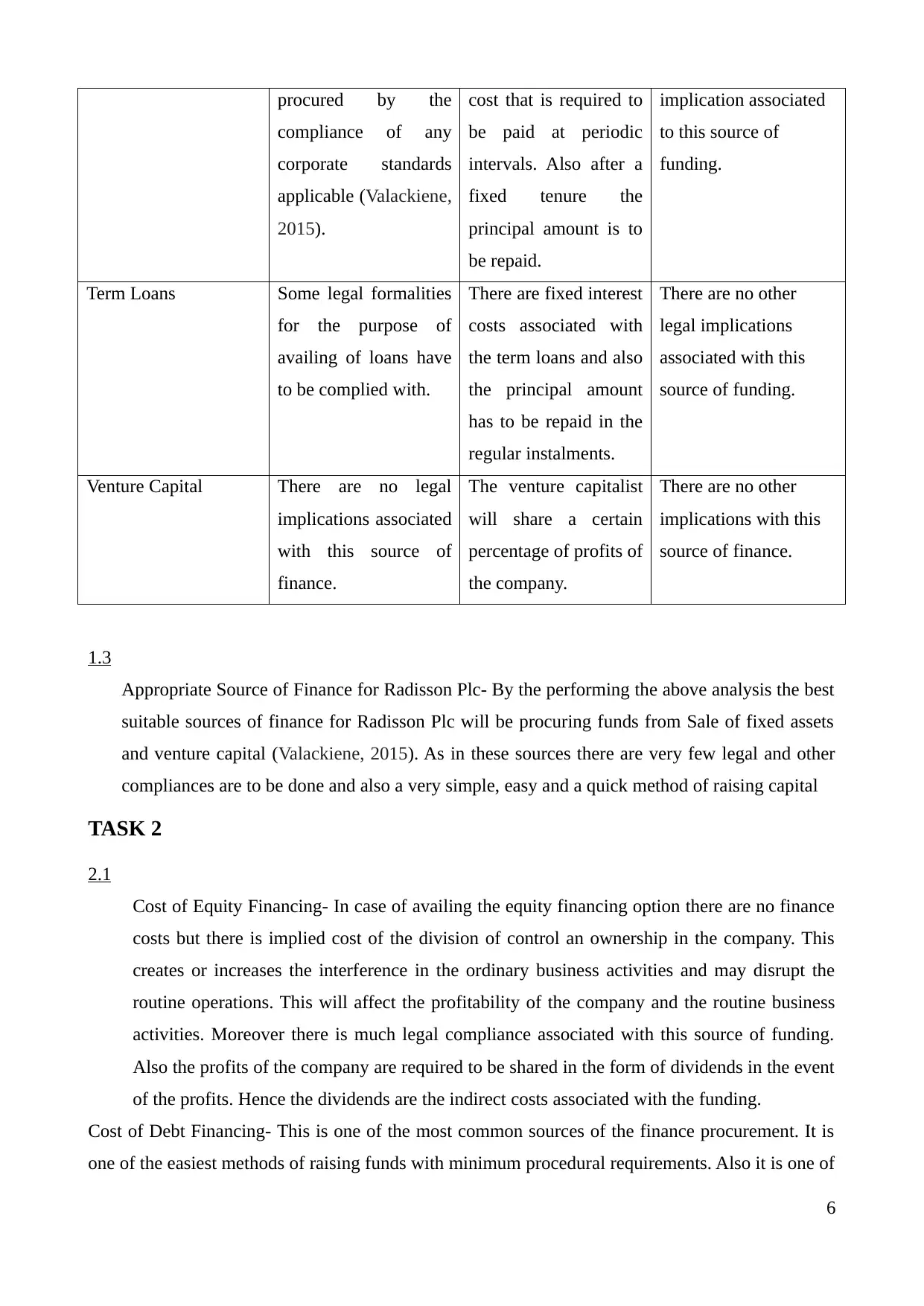
procured by the
compliance of any
corporate standards
applicable (Valackiene,
2015).
cost that is required to
be paid at periodic
intervals. Also after a
fixed tenure the
principal amount is to
be repaid.
implication associated
to this source of
funding.
Term Loans Some legal formalities
for the purpose of
availing of loans have
to be complied with.
There are fixed interest
costs associated with
the term loans and also
the principal amount
has to be repaid in the
regular instalments.
There are no other
legal implications
associated with this
source of funding.
Venture Capital There are no legal
implications associated
with this source of
finance.
The venture capitalist
will share a certain
percentage of profits of
the company.
There are no other
implications with this
source of finance.
1.3
Appropriate Source of Finance for Radisson Plc- By the performing the above analysis the best
suitable sources of finance for Radisson Plc will be procuring funds from Sale of fixed assets
and venture capital (Valackiene, 2015). As in these sources there are very few legal and other
compliances are to be done and also a very simple, easy and a quick method of raising capital
TASK 2
2.1
Cost of Equity Financing- In case of availing the equity financing option there are no finance
costs but there is implied cost of the division of control an ownership in the company. This
creates or increases the interference in the ordinary business activities and may disrupt the
routine operations. This will affect the profitability of the company and the routine business
activities. Moreover there is much legal compliance associated with this source of funding.
Also the profits of the company are required to be shared in the form of dividends in the event
of the profits. Hence the dividends are the indirect costs associated with the funding.
Cost of Debt Financing- This is one of the most common sources of the finance procurement. It is
one of the easiest methods of raising funds with minimum procedural requirements. Also it is one of
6
compliance of any
corporate standards
applicable (Valackiene,
2015).
cost that is required to
be paid at periodic
intervals. Also after a
fixed tenure the
principal amount is to
be repaid.
implication associated
to this source of
funding.
Term Loans Some legal formalities
for the purpose of
availing of loans have
to be complied with.
There are fixed interest
costs associated with
the term loans and also
the principal amount
has to be repaid in the
regular instalments.
There are no other
legal implications
associated with this
source of funding.
Venture Capital There are no legal
implications associated
with this source of
finance.
The venture capitalist
will share a certain
percentage of profits of
the company.
There are no other
implications with this
source of finance.
1.3
Appropriate Source of Finance for Radisson Plc- By the performing the above analysis the best
suitable sources of finance for Radisson Plc will be procuring funds from Sale of fixed assets
and venture capital (Valackiene, 2015). As in these sources there are very few legal and other
compliances are to be done and also a very simple, easy and a quick method of raising capital
TASK 2
2.1
Cost of Equity Financing- In case of availing the equity financing option there are no finance
costs but there is implied cost of the division of control an ownership in the company. This
creates or increases the interference in the ordinary business activities and may disrupt the
routine operations. This will affect the profitability of the company and the routine business
activities. Moreover there is much legal compliance associated with this source of funding.
Also the profits of the company are required to be shared in the form of dividends in the event
of the profits. Hence the dividends are the indirect costs associated with the funding.
Cost of Debt Financing- This is one of the most common sources of the finance procurement. It is
one of the easiest methods of raising funds with minimum procedural requirements. Also it is one of
6
⊘ This is a preview!⊘
Do you want full access?
Subscribe today to unlock all pages.

Trusted by 1+ million students worldwide
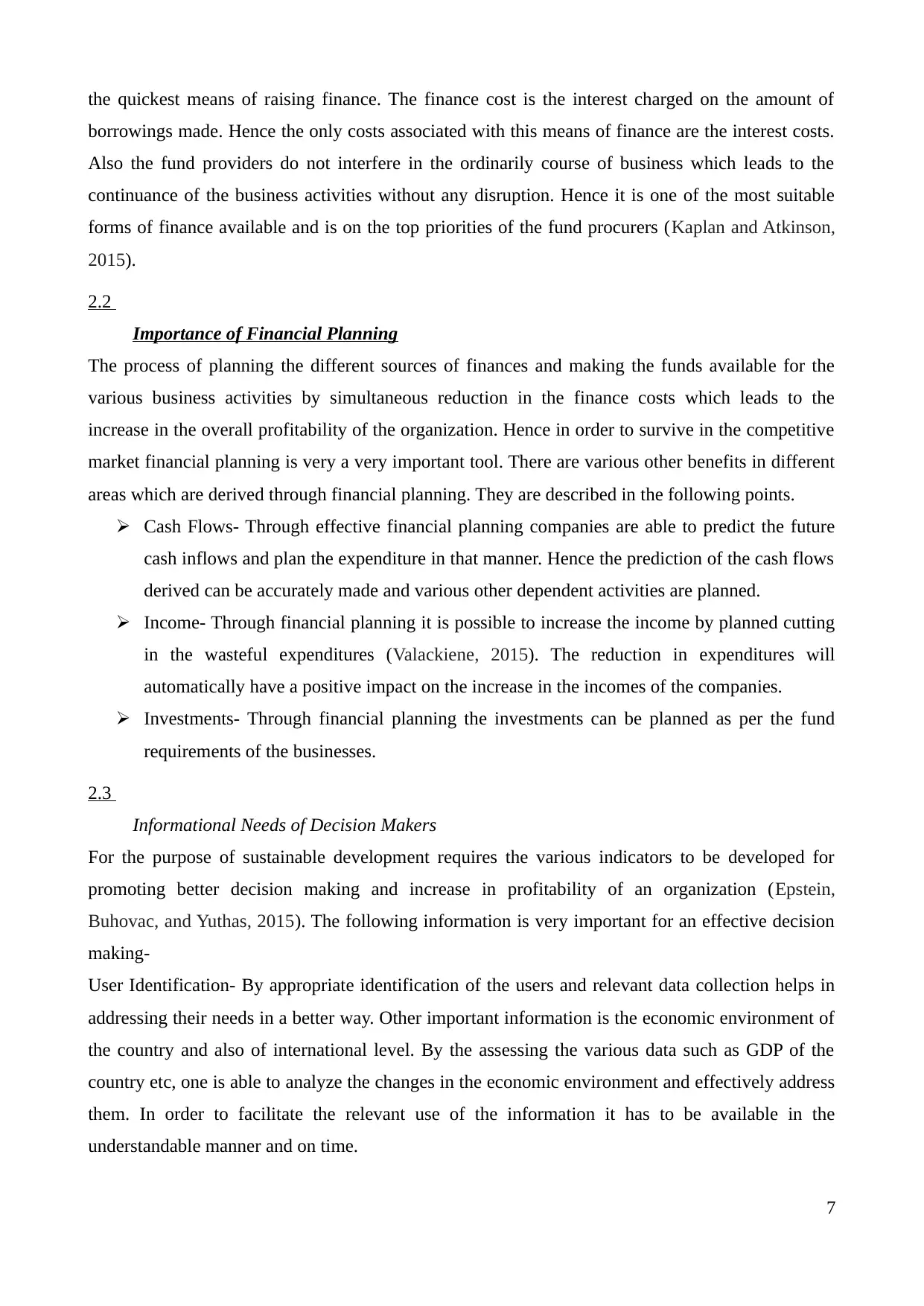
the quickest means of raising finance. The finance cost is the interest charged on the amount of
borrowings made. Hence the only costs associated with this means of finance are the interest costs.
Also the fund providers do not interfere in the ordinarily course of business which leads to the
continuance of the business activities without any disruption. Hence it is one of the most suitable
forms of finance available and is on the top priorities of the fund procurers (Kaplan and Atkinson,
2015).
2.2
Importance of Financial Planning
The process of planning the different sources of finances and making the funds available for the
various business activities by simultaneous reduction in the finance costs which leads to the
increase in the overall profitability of the organization. Hence in order to survive in the competitive
market financial planning is very a very important tool. There are various other benefits in different
areas which are derived through financial planning. They are described in the following points.
Cash Flows- Through effective financial planning companies are able to predict the future
cash inflows and plan the expenditure in that manner. Hence the prediction of the cash flows
derived can be accurately made and various other dependent activities are planned.
Income- Through financial planning it is possible to increase the income by planned cutting
in the wasteful expenditures (Valackiene, 2015). The reduction in expenditures will
automatically have a positive impact on the increase in the incomes of the companies.
Investments- Through financial planning the investments can be planned as per the fund
requirements of the businesses.
2.3
Informational Needs of Decision Makers
For the purpose of sustainable development requires the various indicators to be developed for
promoting better decision making and increase in profitability of an organization (Epstein,
Buhovac, and Yuthas, 2015). The following information is very important for an effective decision
making-
User Identification- By appropriate identification of the users and relevant data collection helps in
addressing their needs in a better way. Other important information is the economic environment of
the country and also of international level. By the assessing the various data such as GDP of the
country etc, one is able to analyze the changes in the economic environment and effectively address
them. In order to facilitate the relevant use of the information it has to be available in the
understandable manner and on time.
7
borrowings made. Hence the only costs associated with this means of finance are the interest costs.
Also the fund providers do not interfere in the ordinarily course of business which leads to the
continuance of the business activities without any disruption. Hence it is one of the most suitable
forms of finance available and is on the top priorities of the fund procurers (Kaplan and Atkinson,
2015).
2.2
Importance of Financial Planning
The process of planning the different sources of finances and making the funds available for the
various business activities by simultaneous reduction in the finance costs which leads to the
increase in the overall profitability of the organization. Hence in order to survive in the competitive
market financial planning is very a very important tool. There are various other benefits in different
areas which are derived through financial planning. They are described in the following points.
Cash Flows- Through effective financial planning companies are able to predict the future
cash inflows and plan the expenditure in that manner. Hence the prediction of the cash flows
derived can be accurately made and various other dependent activities are planned.
Income- Through financial planning it is possible to increase the income by planned cutting
in the wasteful expenditures (Valackiene, 2015). The reduction in expenditures will
automatically have a positive impact on the increase in the incomes of the companies.
Investments- Through financial planning the investments can be planned as per the fund
requirements of the businesses.
2.3
Informational Needs of Decision Makers
For the purpose of sustainable development requires the various indicators to be developed for
promoting better decision making and increase in profitability of an organization (Epstein,
Buhovac, and Yuthas, 2015). The following information is very important for an effective decision
making-
User Identification- By appropriate identification of the users and relevant data collection helps in
addressing their needs in a better way. Other important information is the economic environment of
the country and also of international level. By the assessing the various data such as GDP of the
country etc, one is able to analyze the changes in the economic environment and effectively address
them. In order to facilitate the relevant use of the information it has to be available in the
understandable manner and on time.
7
Paraphrase This Document
Need a fresh take? Get an instant paraphrase of this document with our AI Paraphraser
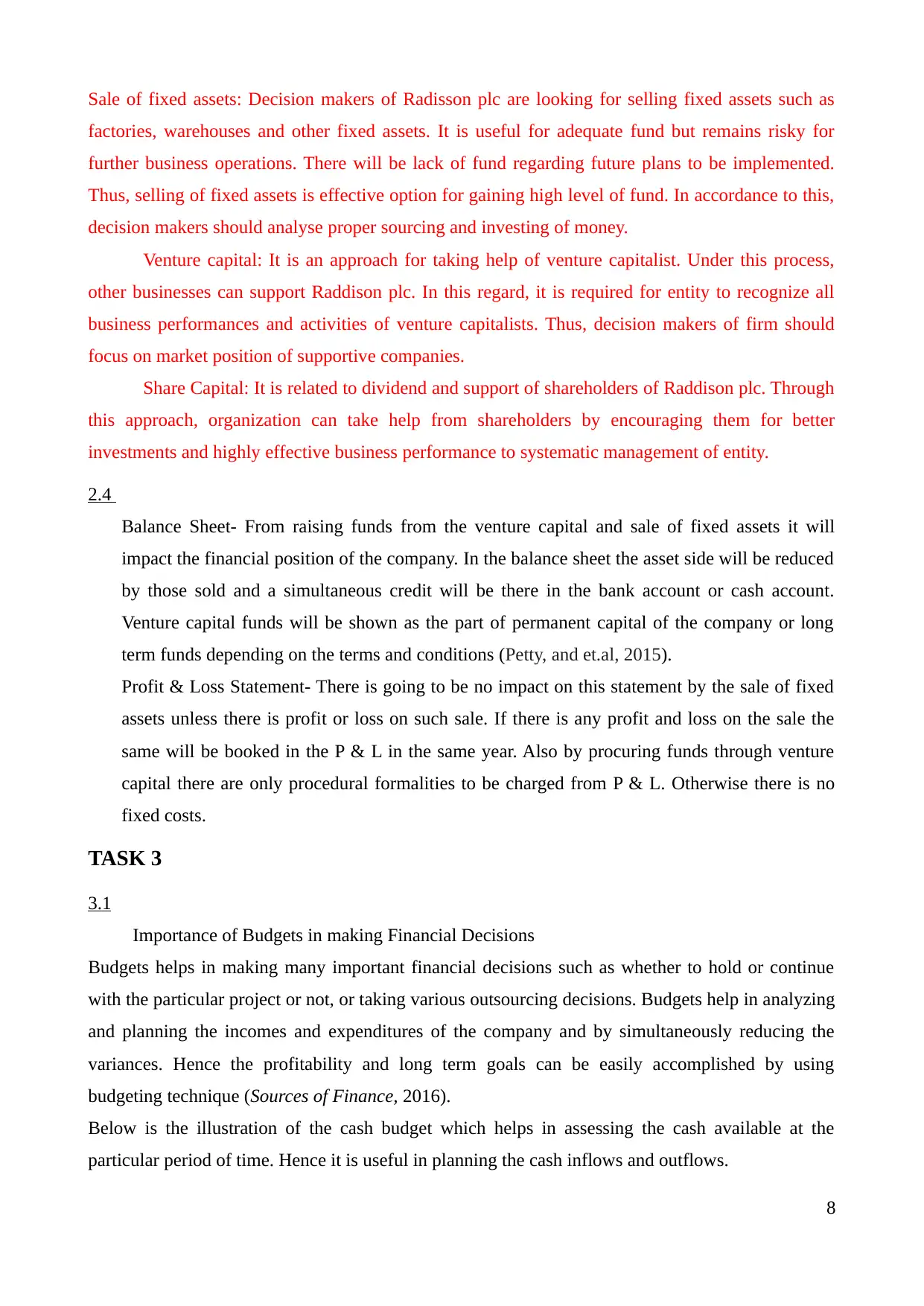
Sale of fixed assets: Decision makers of Radisson plc are looking for selling fixed assets such as
factories, warehouses and other fixed assets. It is useful for adequate fund but remains risky for
further business operations. There will be lack of fund regarding future plans to be implemented.
Thus, selling of fixed assets is effective option for gaining high level of fund. In accordance to this,
decision makers should analyse proper sourcing and investing of money.
Venture capital: It is an approach for taking help of venture capitalist. Under this process,
other businesses can support Raddison plc. In this regard, it is required for entity to recognize all
business performances and activities of venture capitalists. Thus, decision makers of firm should
focus on market position of supportive companies.
Share Capital: It is related to dividend and support of shareholders of Raddison plc. Through
this approach, organization can take help from shareholders by encouraging them for better
investments and highly effective business performance to systematic management of entity.
2.4
Balance Sheet- From raising funds from the venture capital and sale of fixed assets it will
impact the financial position of the company. In the balance sheet the asset side will be reduced
by those sold and a simultaneous credit will be there in the bank account or cash account.
Venture capital funds will be shown as the part of permanent capital of the company or long
term funds depending on the terms and conditions (Petty, and et.al, 2015).
Profit & Loss Statement- There is going to be no impact on this statement by the sale of fixed
assets unless there is profit or loss on such sale. If there is any profit and loss on the sale the
same will be booked in the P & L in the same year. Also by procuring funds through venture
capital there are only procedural formalities to be charged from P & L. Otherwise there is no
fixed costs.
TASK 3
3.1
Importance of Budgets in making Financial Decisions
Budgets helps in making many important financial decisions such as whether to hold or continue
with the particular project or not, or taking various outsourcing decisions. Budgets help in analyzing
and planning the incomes and expenditures of the company and by simultaneously reducing the
variances. Hence the profitability and long term goals can be easily accomplished by using
budgeting technique (Sources of Finance, 2016).
Below is the illustration of the cash budget which helps in assessing the cash available at the
particular period of time. Hence it is useful in planning the cash inflows and outflows.
8
factories, warehouses and other fixed assets. It is useful for adequate fund but remains risky for
further business operations. There will be lack of fund regarding future plans to be implemented.
Thus, selling of fixed assets is effective option for gaining high level of fund. In accordance to this,
decision makers should analyse proper sourcing and investing of money.
Venture capital: It is an approach for taking help of venture capitalist. Under this process,
other businesses can support Raddison plc. In this regard, it is required for entity to recognize all
business performances and activities of venture capitalists. Thus, decision makers of firm should
focus on market position of supportive companies.
Share Capital: It is related to dividend and support of shareholders of Raddison plc. Through
this approach, organization can take help from shareholders by encouraging them for better
investments and highly effective business performance to systematic management of entity.
2.4
Balance Sheet- From raising funds from the venture capital and sale of fixed assets it will
impact the financial position of the company. In the balance sheet the asset side will be reduced
by those sold and a simultaneous credit will be there in the bank account or cash account.
Venture capital funds will be shown as the part of permanent capital of the company or long
term funds depending on the terms and conditions (Petty, and et.al, 2015).
Profit & Loss Statement- There is going to be no impact on this statement by the sale of fixed
assets unless there is profit or loss on such sale. If there is any profit and loss on the sale the
same will be booked in the P & L in the same year. Also by procuring funds through venture
capital there are only procedural formalities to be charged from P & L. Otherwise there is no
fixed costs.
TASK 3
3.1
Importance of Budgets in making Financial Decisions
Budgets helps in making many important financial decisions such as whether to hold or continue
with the particular project or not, or taking various outsourcing decisions. Budgets help in analyzing
and planning the incomes and expenditures of the company and by simultaneously reducing the
variances. Hence the profitability and long term goals can be easily accomplished by using
budgeting technique (Sources of Finance, 2016).
Below is the illustration of the cash budget which helps in assessing the cash available at the
particular period of time. Hence it is useful in planning the cash inflows and outflows.
8
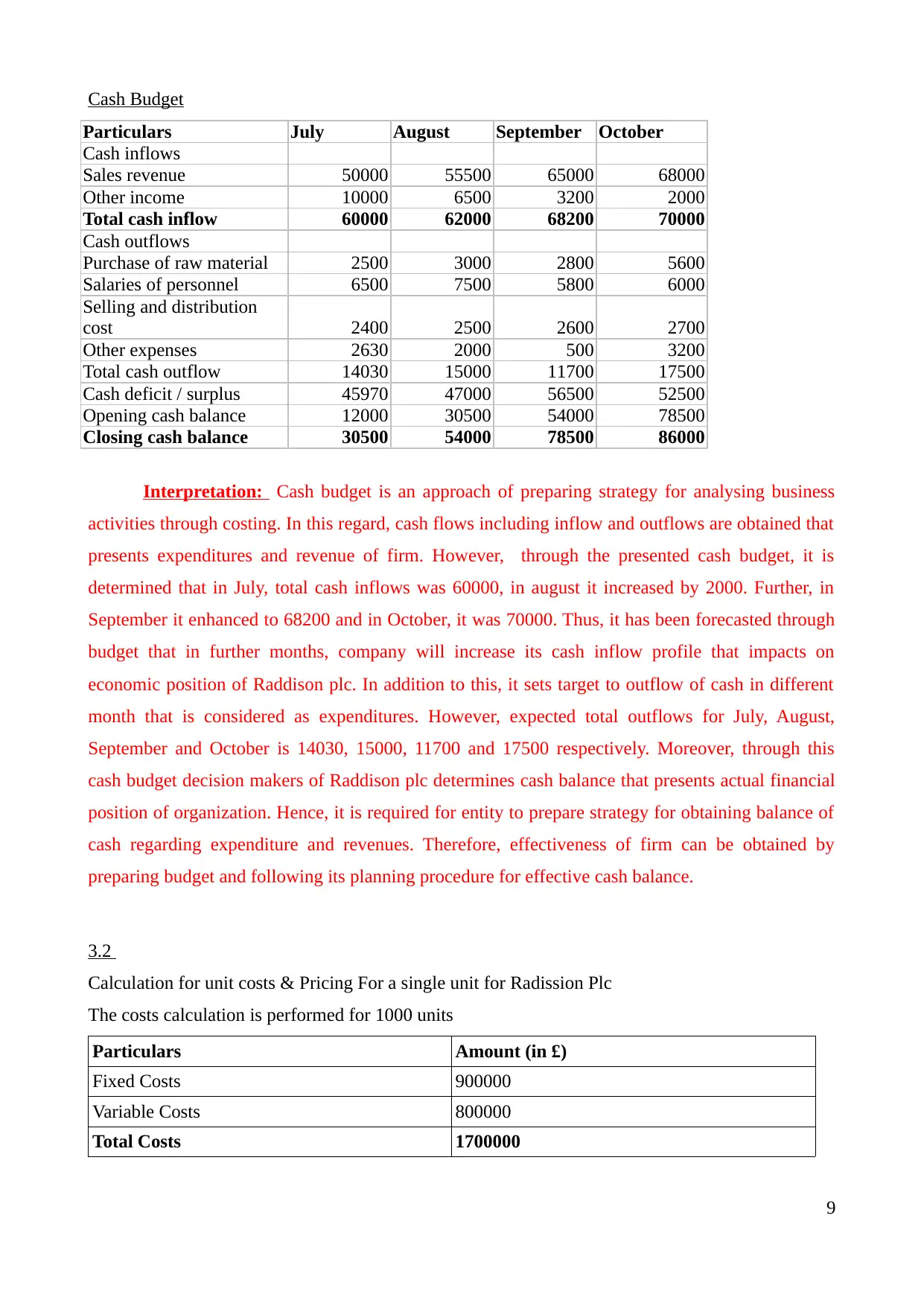
Cash Budget
Particulars July August September October
Cash inflows
Sales revenue 50000 55500 65000 68000
Other income 10000 6500 3200 2000
Total cash inflow 60000 62000 68200 70000
Cash outflows
Purchase of raw material 2500 3000 2800 5600
Salaries of personnel 6500 7500 5800 6000
Selling and distribution
cost 2400 2500 2600 2700
Other expenses 2630 2000 500 3200
Total cash outflow 14030 15000 11700 17500
Cash deficit / surplus 45970 47000 56500 52500
Opening cash balance 12000 30500 54000 78500
Closing cash balance 30500 54000 78500 86000
Interpretation: Cash budget is an approach of preparing strategy for analysing business
activities through costing. In this regard, cash flows including inflow and outflows are obtained that
presents expenditures and revenue of firm. However, through the presented cash budget, it is
determined that in July, total cash inflows was 60000, in august it increased by 2000. Further, in
September it enhanced to 68200 and in October, it was 70000. Thus, it has been forecasted through
budget that in further months, company will increase its cash inflow profile that impacts on
economic position of Raddison plc. In addition to this, it sets target to outflow of cash in different
month that is considered as expenditures. However, expected total outflows for July, August,
September and October is 14030, 15000, 11700 and 17500 respectively. Moreover, through this
cash budget decision makers of Raddison plc determines cash balance that presents actual financial
position of organization. Hence, it is required for entity to prepare strategy for obtaining balance of
cash regarding expenditure and revenues. Therefore, effectiveness of firm can be obtained by
preparing budget and following its planning procedure for effective cash balance.
3.2
Calculation for unit costs & Pricing For a single unit for Radission Plc
The costs calculation is performed for 1000 units
Particulars Amount (in £)
Fixed Costs 900000
Variable Costs 800000
Total Costs 1700000
9
Particulars July August September October
Cash inflows
Sales revenue 50000 55500 65000 68000
Other income 10000 6500 3200 2000
Total cash inflow 60000 62000 68200 70000
Cash outflows
Purchase of raw material 2500 3000 2800 5600
Salaries of personnel 6500 7500 5800 6000
Selling and distribution
cost 2400 2500 2600 2700
Other expenses 2630 2000 500 3200
Total cash outflow 14030 15000 11700 17500
Cash deficit / surplus 45970 47000 56500 52500
Opening cash balance 12000 30500 54000 78500
Closing cash balance 30500 54000 78500 86000
Interpretation: Cash budget is an approach of preparing strategy for analysing business
activities through costing. In this regard, cash flows including inflow and outflows are obtained that
presents expenditures and revenue of firm. However, through the presented cash budget, it is
determined that in July, total cash inflows was 60000, in august it increased by 2000. Further, in
September it enhanced to 68200 and in October, it was 70000. Thus, it has been forecasted through
budget that in further months, company will increase its cash inflow profile that impacts on
economic position of Raddison plc. In addition to this, it sets target to outflow of cash in different
month that is considered as expenditures. However, expected total outflows for July, August,
September and October is 14030, 15000, 11700 and 17500 respectively. Moreover, through this
cash budget decision makers of Raddison plc determines cash balance that presents actual financial
position of organization. Hence, it is required for entity to prepare strategy for obtaining balance of
cash regarding expenditure and revenues. Therefore, effectiveness of firm can be obtained by
preparing budget and following its planning procedure for effective cash balance.
3.2
Calculation for unit costs & Pricing For a single unit for Radission Plc
The costs calculation is performed for 1000 units
Particulars Amount (in £)
Fixed Costs 900000
Variable Costs 800000
Total Costs 1700000
9
⊘ This is a preview!⊘
Do you want full access?
Subscribe today to unlock all pages.

Trusted by 1+ million students worldwide
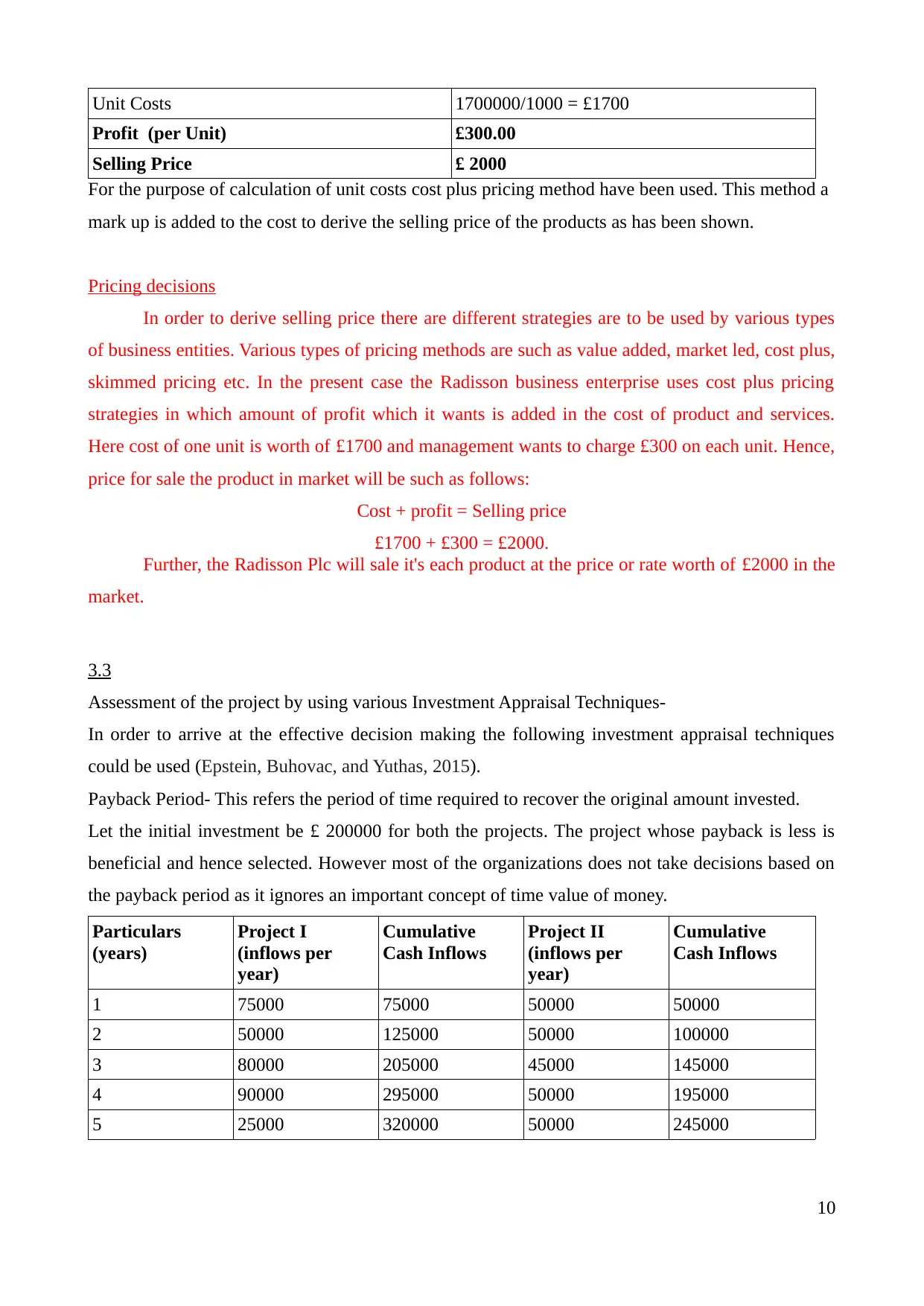
Unit Costs 1700000/1000 = £1700
Profit (per Unit) £300.00
Selling Price £ 2000
For the purpose of calculation of unit costs cost plus pricing method have been used. This method a
mark up is added to the cost to derive the selling price of the products as has been shown.
Pricing decisions
In order to derive selling price there are different strategies are to be used by various types
of business entities. Various types of pricing methods are such as value added, market led, cost plus,
skimmed pricing etc. In the present case the Radisson business enterprise uses cost plus pricing
strategies in which amount of profit which it wants is added in the cost of product and services.
Here cost of one unit is worth of £1700 and management wants to charge £300 on each unit. Hence,
price for sale the product in market will be such as follows:
Cost + profit = Selling price
£1700 + £300 = £2000.
Further, the Radisson Plc will sale it's each product at the price or rate worth of £2000 in the
market.
3.3
Assessment of the project by using various Investment Appraisal Techniques-
In order to arrive at the effective decision making the following investment appraisal techniques
could be used (Epstein, Buhovac, and Yuthas, 2015).
Payback Period- This refers the period of time required to recover the original amount invested.
Let the initial investment be £ 200000 for both the projects. The project whose payback is less is
beneficial and hence selected. However most of the organizations does not take decisions based on
the payback period as it ignores an important concept of time value of money.
Particulars
(years)
Project I
(inflows per
year)
Cumulative
Cash Inflows
Project II
(inflows per
year)
Cumulative
Cash Inflows
1 75000 75000 50000 50000
2 50000 125000 50000 100000
3 80000 205000 45000 145000
4 90000 295000 50000 195000
5 25000 320000 50000 245000
10
Profit (per Unit) £300.00
Selling Price £ 2000
For the purpose of calculation of unit costs cost plus pricing method have been used. This method a
mark up is added to the cost to derive the selling price of the products as has been shown.
Pricing decisions
In order to derive selling price there are different strategies are to be used by various types
of business entities. Various types of pricing methods are such as value added, market led, cost plus,
skimmed pricing etc. In the present case the Radisson business enterprise uses cost plus pricing
strategies in which amount of profit which it wants is added in the cost of product and services.
Here cost of one unit is worth of £1700 and management wants to charge £300 on each unit. Hence,
price for sale the product in market will be such as follows:
Cost + profit = Selling price
£1700 + £300 = £2000.
Further, the Radisson Plc will sale it's each product at the price or rate worth of £2000 in the
market.
3.3
Assessment of the project by using various Investment Appraisal Techniques-
In order to arrive at the effective decision making the following investment appraisal techniques
could be used (Epstein, Buhovac, and Yuthas, 2015).
Payback Period- This refers the period of time required to recover the original amount invested.
Let the initial investment be £ 200000 for both the projects. The project whose payback is less is
beneficial and hence selected. However most of the organizations does not take decisions based on
the payback period as it ignores an important concept of time value of money.
Particulars
(years)
Project I
(inflows per
year)
Cumulative
Cash Inflows
Project II
(inflows per
year)
Cumulative
Cash Inflows
1 75000 75000 50000 50000
2 50000 125000 50000 100000
3 80000 205000 45000 145000
4 90000 295000 50000 195000
5 25000 320000 50000 245000
10
Paraphrase This Document
Need a fresh take? Get an instant paraphrase of this document with our AI Paraphraser
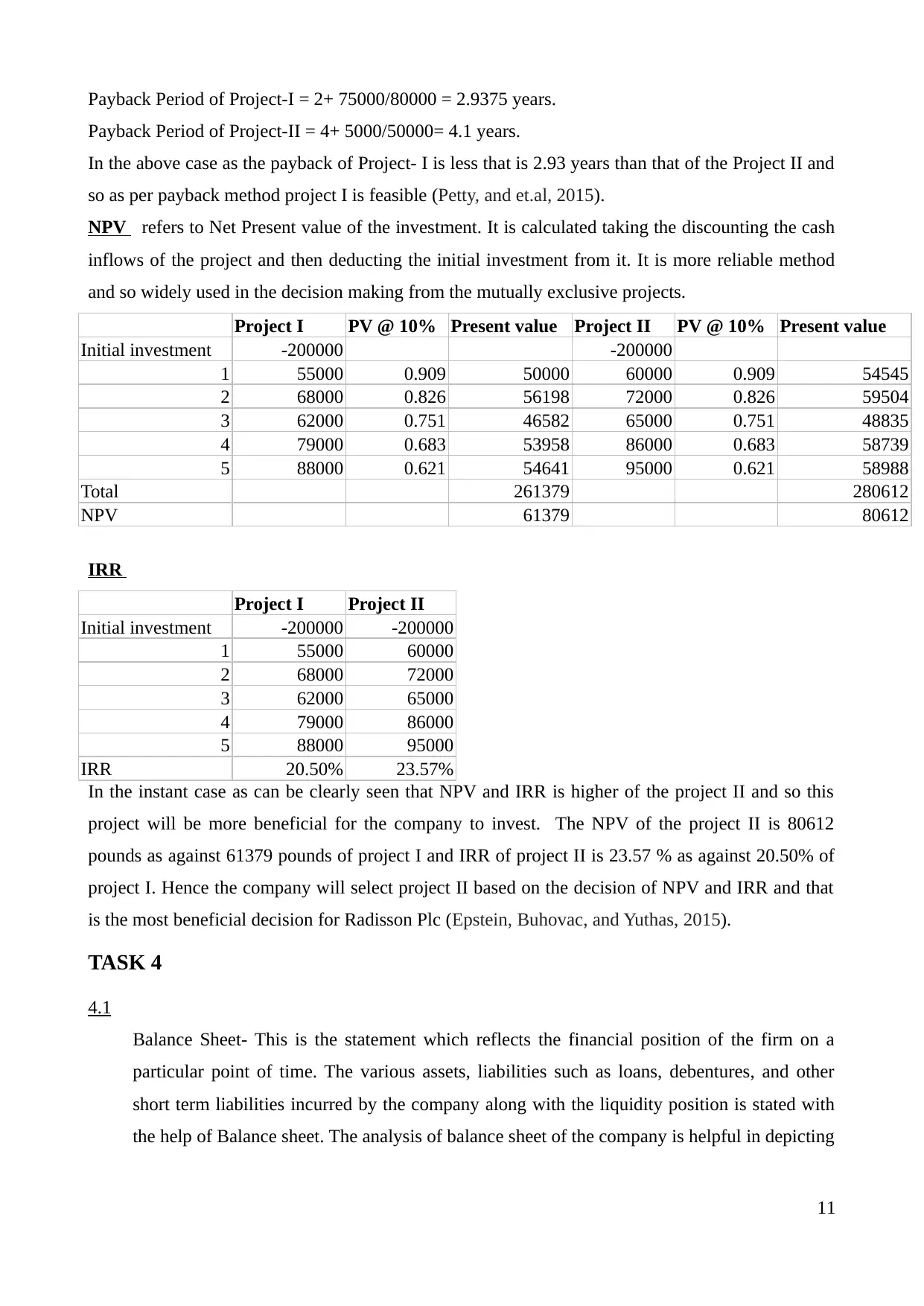
Payback Period of Project-I = 2+ 75000/80000 = 2.9375 years.
Payback Period of Project-II = 4+ 5000/50000= 4.1 years.
In the above case as the payback of Project- I is less that is 2.93 years than that of the Project II and
so as per payback method project I is feasible (Petty, and et.al, 2015).
NPV refers to Net Present value of the investment. It is calculated taking the discounting the cash
inflows of the project and then deducting the initial investment from it. It is more reliable method
and so widely used in the decision making from the mutually exclusive projects.
Project I PV @ 10% Present value Project II PV @ 10% Present value
Initial investment -200000 -200000
1 55000 0.909 50000 60000 0.909 54545
2 68000 0.826 56198 72000 0.826 59504
3 62000 0.751 46582 65000 0.751 48835
4 79000 0.683 53958 86000 0.683 58739
5 88000 0.621 54641 95000 0.621 58988
Total 261379 280612
NPV 61379 80612
IRR
Project I Project II
Initial investment -200000 -200000
1 55000 60000
2 68000 72000
3 62000 65000
4 79000 86000
5 88000 95000
IRR 20.50% 23.57%
In the instant case as can be clearly seen that NPV and IRR is higher of the project II and so this
project will be more beneficial for the company to invest. The NPV of the project II is 80612
pounds as against 61379 pounds of project I and IRR of project II is 23.57 % as against 20.50% of
project I. Hence the company will select project II based on the decision of NPV and IRR and that
is the most beneficial decision for Radisson Plc (Epstein, Buhovac, and Yuthas, 2015).
TASK 4
4.1
Balance Sheet- This is the statement which reflects the financial position of the firm on a
particular point of time. The various assets, liabilities such as loans, debentures, and other
short term liabilities incurred by the company along with the liquidity position is stated with
the help of Balance sheet. The analysis of balance sheet of the company is helpful in depicting
11
Payback Period of Project-II = 4+ 5000/50000= 4.1 years.
In the above case as the payback of Project- I is less that is 2.93 years than that of the Project II and
so as per payback method project I is feasible (Petty, and et.al, 2015).
NPV refers to Net Present value of the investment. It is calculated taking the discounting the cash
inflows of the project and then deducting the initial investment from it. It is more reliable method
and so widely used in the decision making from the mutually exclusive projects.
Project I PV @ 10% Present value Project II PV @ 10% Present value
Initial investment -200000 -200000
1 55000 0.909 50000 60000 0.909 54545
2 68000 0.826 56198 72000 0.826 59504
3 62000 0.751 46582 65000 0.751 48835
4 79000 0.683 53958 86000 0.683 58739
5 88000 0.621 54641 95000 0.621 58988
Total 261379 280612
NPV 61379 80612
IRR
Project I Project II
Initial investment -200000 -200000
1 55000 60000
2 68000 72000
3 62000 65000
4 79000 86000
5 88000 95000
IRR 20.50% 23.57%
In the instant case as can be clearly seen that NPV and IRR is higher of the project II and so this
project will be more beneficial for the company to invest. The NPV of the project II is 80612
pounds as against 61379 pounds of project I and IRR of project II is 23.57 % as against 20.50% of
project I. Hence the company will select project II based on the decision of NPV and IRR and that
is the most beneficial decision for Radisson Plc (Epstein, Buhovac, and Yuthas, 2015).
TASK 4
4.1
Balance Sheet- This is the statement which reflects the financial position of the firm on a
particular point of time. The various assets, liabilities such as loans, debentures, and other
short term liabilities incurred by the company along with the liquidity position is stated with
the help of Balance sheet. The analysis of balance sheet of the company is helpful in depicting
11
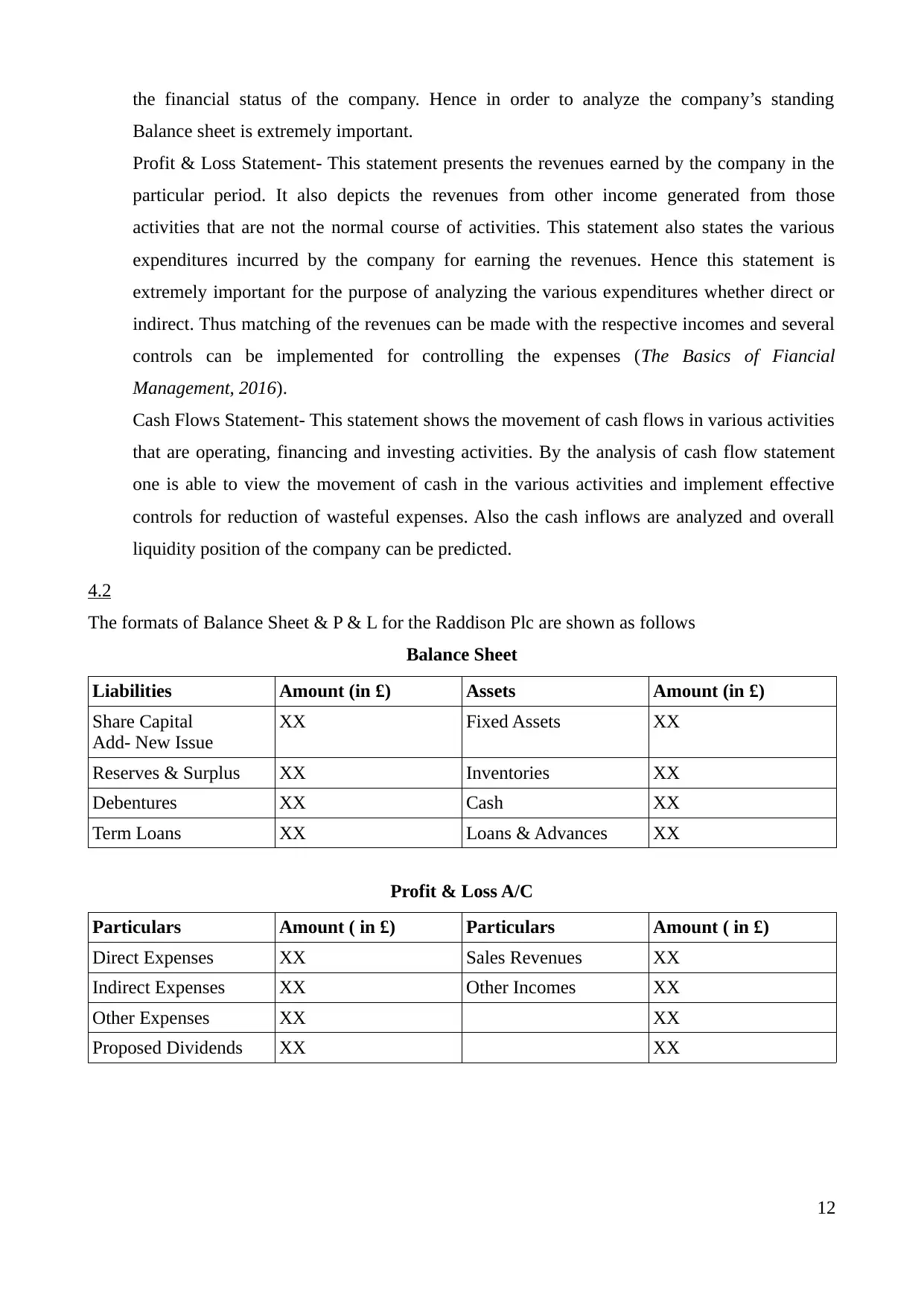
the financial status of the company. Hence in order to analyze the company’s standing
Balance sheet is extremely important.
Profit & Loss Statement- This statement presents the revenues earned by the company in the
particular period. It also depicts the revenues from other income generated from those
activities that are not the normal course of activities. This statement also states the various
expenditures incurred by the company for earning the revenues. Hence this statement is
extremely important for the purpose of analyzing the various expenditures whether direct or
indirect. Thus matching of the revenues can be made with the respective incomes and several
controls can be implemented for controlling the expenses (The Basics of Fiancial
Management, 2016).
Cash Flows Statement- This statement shows the movement of cash flows in various activities
that are operating, financing and investing activities. By the analysis of cash flow statement
one is able to view the movement of cash in the various activities and implement effective
controls for reduction of wasteful expenses. Also the cash inflows are analyzed and overall
liquidity position of the company can be predicted.
4.2
The formats of Balance Sheet & P & L for the Raddison Plc are shown as follows
Balance Sheet
Liabilities Amount (in £) Assets Amount (in £)
Share Capital
Add- New Issue
XX Fixed Assets XX
Reserves & Surplus XX Inventories XX
Debentures XX Cash XX
Term Loans XX Loans & Advances XX
Profit & Loss A/C
Particulars Amount ( in £) Particulars Amount ( in £)
Direct Expenses XX Sales Revenues XX
Indirect Expenses XX Other Incomes XX
Other Expenses XX XX
Proposed Dividends XX XX
12
Balance sheet is extremely important.
Profit & Loss Statement- This statement presents the revenues earned by the company in the
particular period. It also depicts the revenues from other income generated from those
activities that are not the normal course of activities. This statement also states the various
expenditures incurred by the company for earning the revenues. Hence this statement is
extremely important for the purpose of analyzing the various expenditures whether direct or
indirect. Thus matching of the revenues can be made with the respective incomes and several
controls can be implemented for controlling the expenses (The Basics of Fiancial
Management, 2016).
Cash Flows Statement- This statement shows the movement of cash flows in various activities
that are operating, financing and investing activities. By the analysis of cash flow statement
one is able to view the movement of cash in the various activities and implement effective
controls for reduction of wasteful expenses. Also the cash inflows are analyzed and overall
liquidity position of the company can be predicted.
4.2
The formats of Balance Sheet & P & L for the Raddison Plc are shown as follows
Balance Sheet
Liabilities Amount (in £) Assets Amount (in £)
Share Capital
Add- New Issue
XX Fixed Assets XX
Reserves & Surplus XX Inventories XX
Debentures XX Cash XX
Term Loans XX Loans & Advances XX
Profit & Loss A/C
Particulars Amount ( in £) Particulars Amount ( in £)
Direct Expenses XX Sales Revenues XX
Indirect Expenses XX Other Incomes XX
Other Expenses XX XX
Proposed Dividends XX XX
12
⊘ This is a preview!⊘
Do you want full access?
Subscribe today to unlock all pages.

Trusted by 1+ million students worldwide
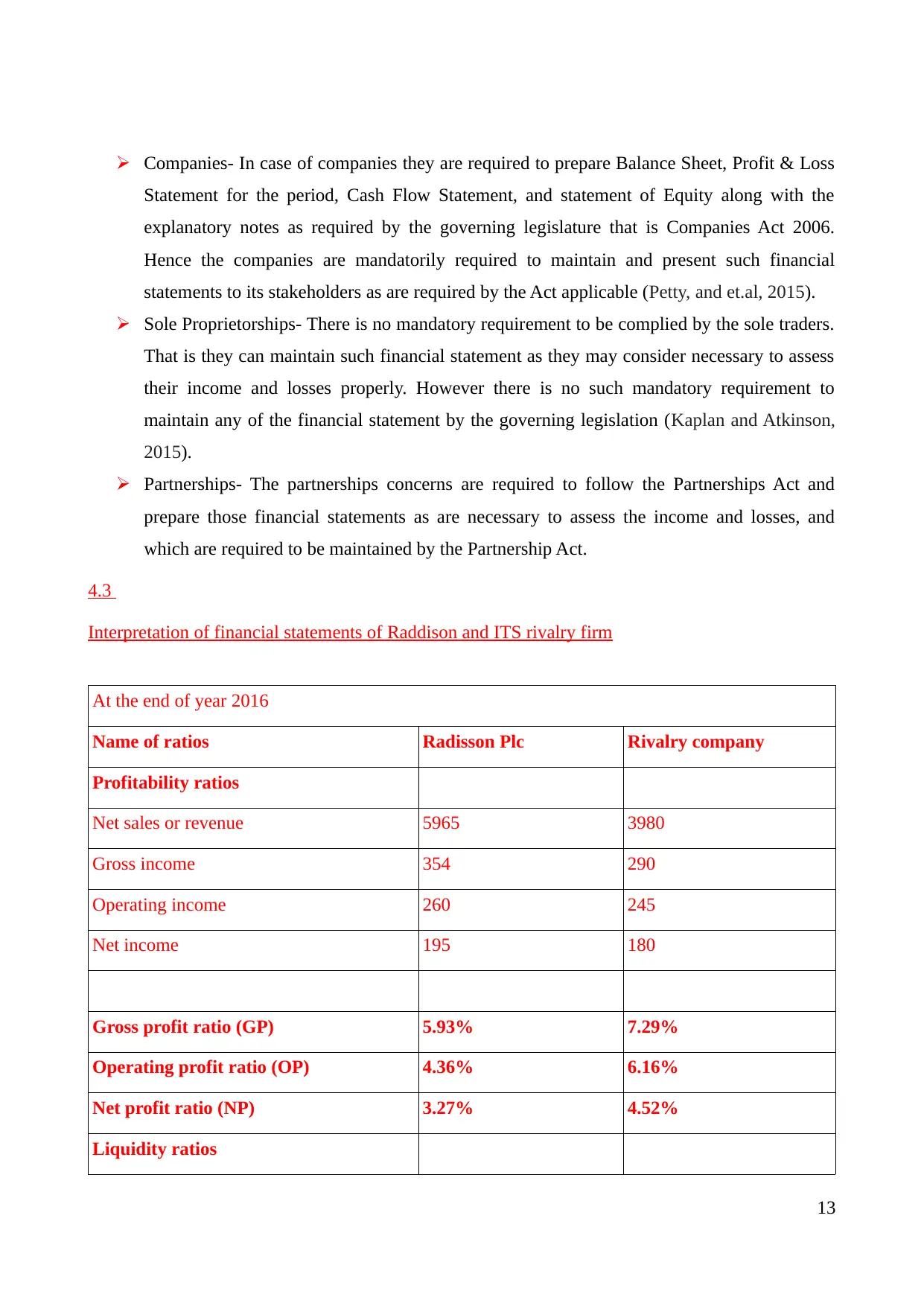
Companies- In case of companies they are required to prepare Balance Sheet, Profit & Loss
Statement for the period, Cash Flow Statement, and statement of Equity along with the
explanatory notes as required by the governing legislature that is Companies Act 2006.
Hence the companies are mandatorily required to maintain and present such financial
statements to its stakeholders as are required by the Act applicable (Petty, and et.al, 2015).
Sole Proprietorships- There is no mandatory requirement to be complied by the sole traders.
That is they can maintain such financial statement as they may consider necessary to assess
their income and losses properly. However there is no such mandatory requirement to
maintain any of the financial statement by the governing legislation (Kaplan and Atkinson,
2015).
Partnerships- The partnerships concerns are required to follow the Partnerships Act and
prepare those financial statements as are necessary to assess the income and losses, and
which are required to be maintained by the Partnership Act.
4.3
Interpretation of financial statements of Raddison and ITS rivalry firm
At the end of year 2016
Name of ratios Radisson Plc Rivalry company
Profitability ratios
Net sales or revenue 5965 3980
Gross income 354 290
Operating income 260 245
Net income 195 180
Gross profit ratio (GP) 5.93% 7.29%
Operating profit ratio (OP) 4.36% 6.16%
Net profit ratio (NP) 3.27% 4.52%
Liquidity ratios
13
Statement for the period, Cash Flow Statement, and statement of Equity along with the
explanatory notes as required by the governing legislature that is Companies Act 2006.
Hence the companies are mandatorily required to maintain and present such financial
statements to its stakeholders as are required by the Act applicable (Petty, and et.al, 2015).
Sole Proprietorships- There is no mandatory requirement to be complied by the sole traders.
That is they can maintain such financial statement as they may consider necessary to assess
their income and losses properly. However there is no such mandatory requirement to
maintain any of the financial statement by the governing legislation (Kaplan and Atkinson,
2015).
Partnerships- The partnerships concerns are required to follow the Partnerships Act and
prepare those financial statements as are necessary to assess the income and losses, and
which are required to be maintained by the Partnership Act.
4.3
Interpretation of financial statements of Raddison and ITS rivalry firm
At the end of year 2016
Name of ratios Radisson Plc Rivalry company
Profitability ratios
Net sales or revenue 5965 3980
Gross income 354 290
Operating income 260 245
Net income 195 180
Gross profit ratio (GP) 5.93% 7.29%
Operating profit ratio (OP) 4.36% 6.16%
Net profit ratio (NP) 3.27% 4.52%
Liquidity ratios
13
Paraphrase This Document
Need a fresh take? Get an instant paraphrase of this document with our AI Paraphraser
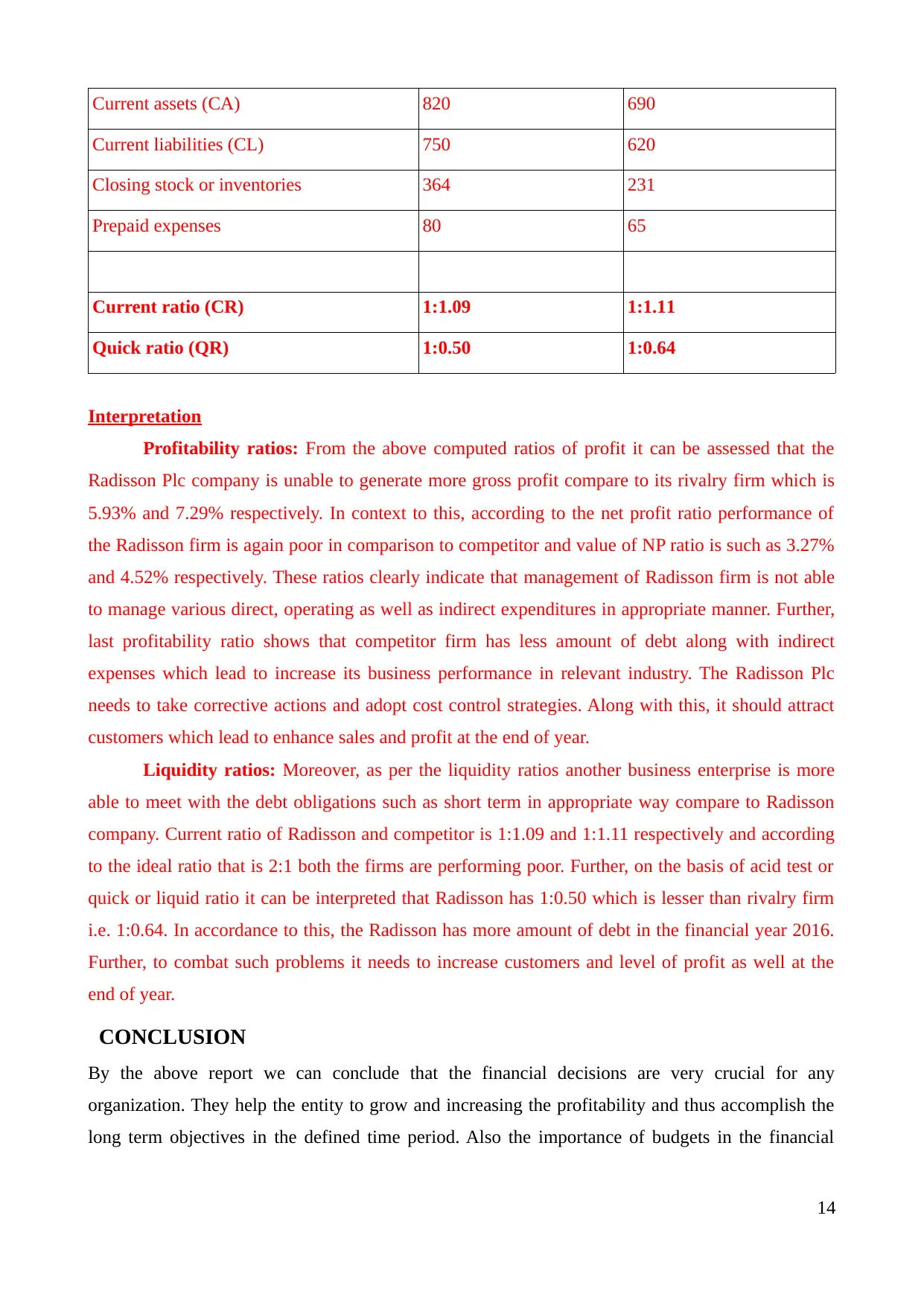
Current assets (CA) 820 690
Current liabilities (CL) 750 620
Closing stock or inventories 364 231
Prepaid expenses 80 65
Current ratio (CR) 1:1.09 1:1.11
Quick ratio (QR) 1:0.50 1:0.64
Interpretation
Profitability ratios: From the above computed ratios of profit it can be assessed that the
Radisson Plc company is unable to generate more gross profit compare to its rivalry firm which is
5.93% and 7.29% respectively. In context to this, according to the net profit ratio performance of
the Radisson firm is again poor in comparison to competitor and value of NP ratio is such as 3.27%
and 4.52% respectively. These ratios clearly indicate that management of Radisson firm is not able
to manage various direct, operating as well as indirect expenditures in appropriate manner. Further,
last profitability ratio shows that competitor firm has less amount of debt along with indirect
expenses which lead to increase its business performance in relevant industry. The Radisson Plc
needs to take corrective actions and adopt cost control strategies. Along with this, it should attract
customers which lead to enhance sales and profit at the end of year.
Liquidity ratios: Moreover, as per the liquidity ratios another business enterprise is more
able to meet with the debt obligations such as short term in appropriate way compare to Radisson
company. Current ratio of Radisson and competitor is 1:1.09 and 1:1.11 respectively and according
to the ideal ratio that is 2:1 both the firms are performing poor. Further, on the basis of acid test or
quick or liquid ratio it can be interpreted that Radisson has 1:0.50 which is lesser than rivalry firm
i.e. 1:0.64. In accordance to this, the Radisson has more amount of debt in the financial year 2016.
Further, to combat such problems it needs to increase customers and level of profit as well at the
end of year.
CONCLUSION
By the above report we can conclude that the financial decisions are very crucial for any
organization. They help the entity to grow and increasing the profitability and thus accomplish the
long term objectives in the defined time period. Also the importance of budgets in the financial
14
Current liabilities (CL) 750 620
Closing stock or inventories 364 231
Prepaid expenses 80 65
Current ratio (CR) 1:1.09 1:1.11
Quick ratio (QR) 1:0.50 1:0.64
Interpretation
Profitability ratios: From the above computed ratios of profit it can be assessed that the
Radisson Plc company is unable to generate more gross profit compare to its rivalry firm which is
5.93% and 7.29% respectively. In context to this, according to the net profit ratio performance of
the Radisson firm is again poor in comparison to competitor and value of NP ratio is such as 3.27%
and 4.52% respectively. These ratios clearly indicate that management of Radisson firm is not able
to manage various direct, operating as well as indirect expenditures in appropriate manner. Further,
last profitability ratio shows that competitor firm has less amount of debt along with indirect
expenses which lead to increase its business performance in relevant industry. The Radisson Plc
needs to take corrective actions and adopt cost control strategies. Along with this, it should attract
customers which lead to enhance sales and profit at the end of year.
Liquidity ratios: Moreover, as per the liquidity ratios another business enterprise is more
able to meet with the debt obligations such as short term in appropriate way compare to Radisson
company. Current ratio of Radisson and competitor is 1:1.09 and 1:1.11 respectively and according
to the ideal ratio that is 2:1 both the firms are performing poor. Further, on the basis of acid test or
quick or liquid ratio it can be interpreted that Radisson has 1:0.50 which is lesser than rivalry firm
i.e. 1:0.64. In accordance to this, the Radisson has more amount of debt in the financial year 2016.
Further, to combat such problems it needs to increase customers and level of profit as well at the
end of year.
CONCLUSION
By the above report we can conclude that the financial decisions are very crucial for any
organization. They help the entity to grow and increasing the profitability and thus accomplish the
long term objectives in the defined time period. Also the importance of budgets in the financial
14
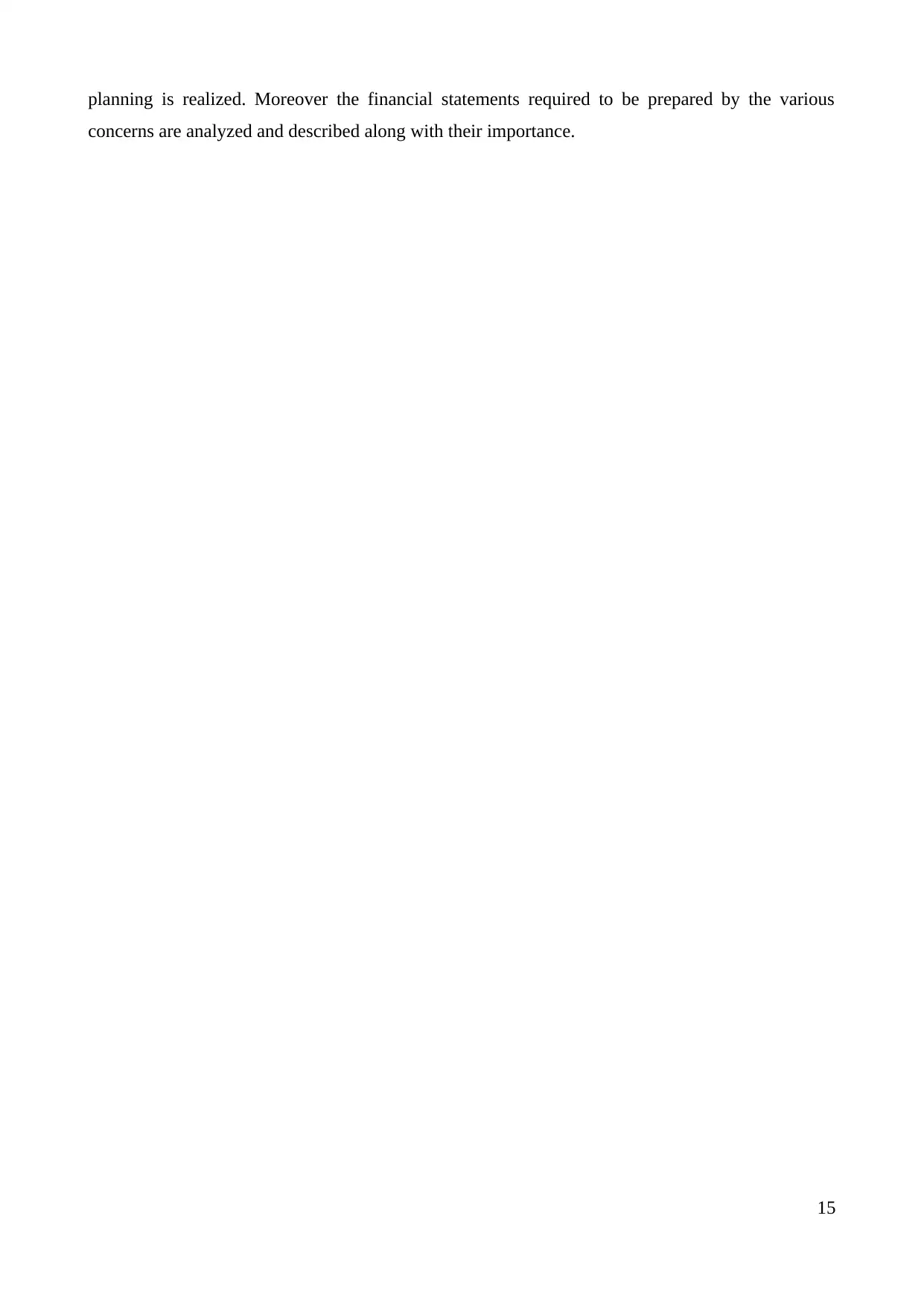
planning is realized. Moreover the financial statements required to be prepared by the various
concerns are analyzed and described along with their importance.
15
concerns are analyzed and described along with their importance.
15
⊘ This is a preview!⊘
Do you want full access?
Subscribe today to unlock all pages.

Trusted by 1+ million students worldwide
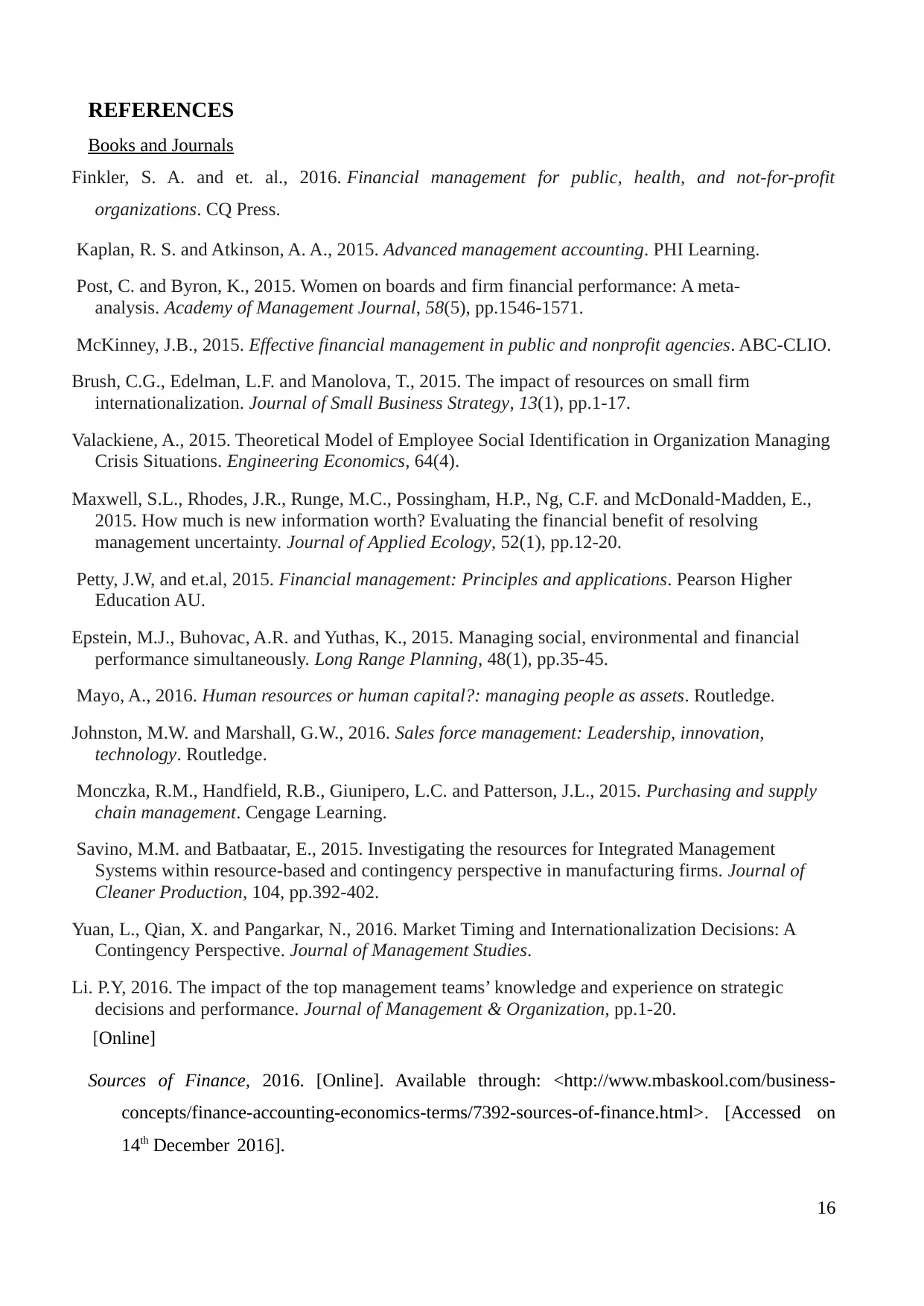
REFERENCES
Books and Journals
Finkler, S. A. and et. al., 2016. Financial management for public, health, and not-for-profit
organizations. CQ Press.
Kaplan, R. S. and Atkinson, A. A., 2015. Advanced management accounting. PHI Learning.
Post, C. and Byron, K., 2015. Women on boards and firm financial performance: A meta-
analysis. Academy of Management Journal, 58(5), pp.1546-1571.
McKinney, J.B., 2015. Effective financial management in public and nonprofit agencies. ABC-CLIO.
Brush, C.G., Edelman, L.F. and Manolova, T., 2015. The impact of resources on small firm
internationalization. Journal of Small Business Strategy, 13(1), pp.1-17.
Valackiene, A., 2015. Theoretical Model of Employee Social Identification in Organization Managing
Crisis Situations. Engineering Economics, 64(4).
Maxwell, S.L., Rhodes, J.R., Runge, M.C., Possingham, H.P., Ng, C.F. and McDonald‐Madden, E.,
2015. How much is new information worth? Evaluating the financial benefit of resolving
management uncertainty. Journal of Applied Ecology, 52(1), pp.12-20.
Petty, J.W, and et.al, 2015. Financial management: Principles and applications. Pearson Higher
Education AU.
Epstein, M.J., Buhovac, A.R. and Yuthas, K., 2015. Managing social, environmental and financial
performance simultaneously. Long Range Planning, 48(1), pp.35-45.
Mayo, A., 2016. Human resources or human capital?: managing people as assets. Routledge.
Johnston, M.W. and Marshall, G.W., 2016. Sales force management: Leadership, innovation,
technology. Routledge.
Monczka, R.M., Handfield, R.B., Giunipero, L.C. and Patterson, J.L., 2015. Purchasing and supply
chain management. Cengage Learning.
Savino, M.M. and Batbaatar, E., 2015. Investigating the resources for Integrated Management
Systems within resource-based and contingency perspective in manufacturing firms. Journal of
Cleaner Production, 104, pp.392-402.
Yuan, L., Qian, X. and Pangarkar, N., 2016. Market Timing and Internationalization Decisions: A
Contingency Perspective. Journal of Management Studies.
Li. P.Y, 2016. The impact of the top management teams’ knowledge and experience on strategic
decisions and performance. Journal of Management & Organization, pp.1-20.
[Online]
Sources of Finance, 2016. [Online]. Available through: <http://www.mbaskool.com/business-
concepts/finance-accounting-economics-terms/7392-sources-of-finance.html>. [Accessed on
14th December 2016].
16
Books and Journals
Finkler, S. A. and et. al., 2016. Financial management for public, health, and not-for-profit
organizations. CQ Press.
Kaplan, R. S. and Atkinson, A. A., 2015. Advanced management accounting. PHI Learning.
Post, C. and Byron, K., 2015. Women on boards and firm financial performance: A meta-
analysis. Academy of Management Journal, 58(5), pp.1546-1571.
McKinney, J.B., 2015. Effective financial management in public and nonprofit agencies. ABC-CLIO.
Brush, C.G., Edelman, L.F. and Manolova, T., 2015. The impact of resources on small firm
internationalization. Journal of Small Business Strategy, 13(1), pp.1-17.
Valackiene, A., 2015. Theoretical Model of Employee Social Identification in Organization Managing
Crisis Situations. Engineering Economics, 64(4).
Maxwell, S.L., Rhodes, J.R., Runge, M.C., Possingham, H.P., Ng, C.F. and McDonald‐Madden, E.,
2015. How much is new information worth? Evaluating the financial benefit of resolving
management uncertainty. Journal of Applied Ecology, 52(1), pp.12-20.
Petty, J.W, and et.al, 2015. Financial management: Principles and applications. Pearson Higher
Education AU.
Epstein, M.J., Buhovac, A.R. and Yuthas, K., 2015. Managing social, environmental and financial
performance simultaneously. Long Range Planning, 48(1), pp.35-45.
Mayo, A., 2016. Human resources or human capital?: managing people as assets. Routledge.
Johnston, M.W. and Marshall, G.W., 2016. Sales force management: Leadership, innovation,
technology. Routledge.
Monczka, R.M., Handfield, R.B., Giunipero, L.C. and Patterson, J.L., 2015. Purchasing and supply
chain management. Cengage Learning.
Savino, M.M. and Batbaatar, E., 2015. Investigating the resources for Integrated Management
Systems within resource-based and contingency perspective in manufacturing firms. Journal of
Cleaner Production, 104, pp.392-402.
Yuan, L., Qian, X. and Pangarkar, N., 2016. Market Timing and Internationalization Decisions: A
Contingency Perspective. Journal of Management Studies.
Li. P.Y, 2016. The impact of the top management teams’ knowledge and experience on strategic
decisions and performance. Journal of Management & Organization, pp.1-20.
[Online]
Sources of Finance, 2016. [Online]. Available through: <http://www.mbaskool.com/business-
concepts/finance-accounting-economics-terms/7392-sources-of-finance.html>. [Accessed on
14th December 2016].
16
Paraphrase This Document
Need a fresh take? Get an instant paraphrase of this document with our AI Paraphraser
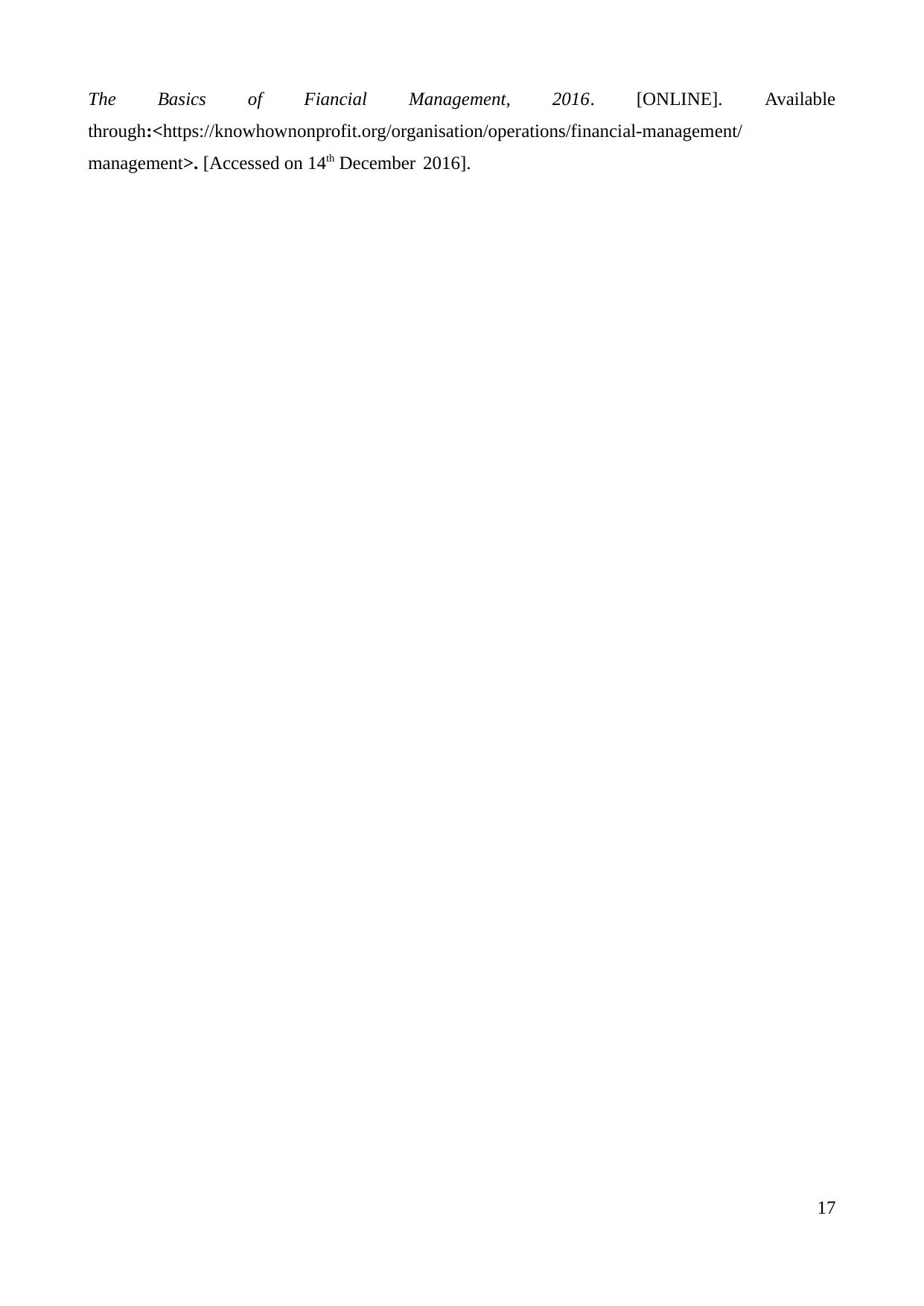
The Basics of Fiancial Management, 2016. [ONLINE]. Available
through:<https://knowhownonprofit.org/organisation/operations/financial-management/
management>. [Accessed on 14th December 2016].
17
through:<https://knowhownonprofit.org/organisation/operations/financial-management/
management>. [Accessed on 14th December 2016].
17
1 out of 17
Related Documents
Your All-in-One AI-Powered Toolkit for Academic Success.
+13062052269
info@desklib.com
Available 24*7 on WhatsApp / Email
![[object Object]](/_next/static/media/star-bottom.7253800d.svg)
Unlock your academic potential
© 2024 | Zucol Services PVT LTD | All rights reserved.





